Landforms Of The Coastal Plains
The earth is a fascinating place with all kinds of variation and geographical interest. Take yous ever seen an unlabeled picture come up every bit a screensaver and been able to estimate where information technology's at based on the types of landforms in the moving picture?
The reason you could is that all over the earth, wild and wondrous things have happened. These occurrences have created a serial of landforms throughout Earth's lifespan that make each many areas unique.
Need to know about the highest mountains in the world? Want to know what a mid-sea ridge is and where they are at on the globe? You have come to the right identify. In this commodity, we dig into the incredible face of our planet. You will larn near what landforms are and the broad diverseness of them arranged beyond the world.
What is a Landform?
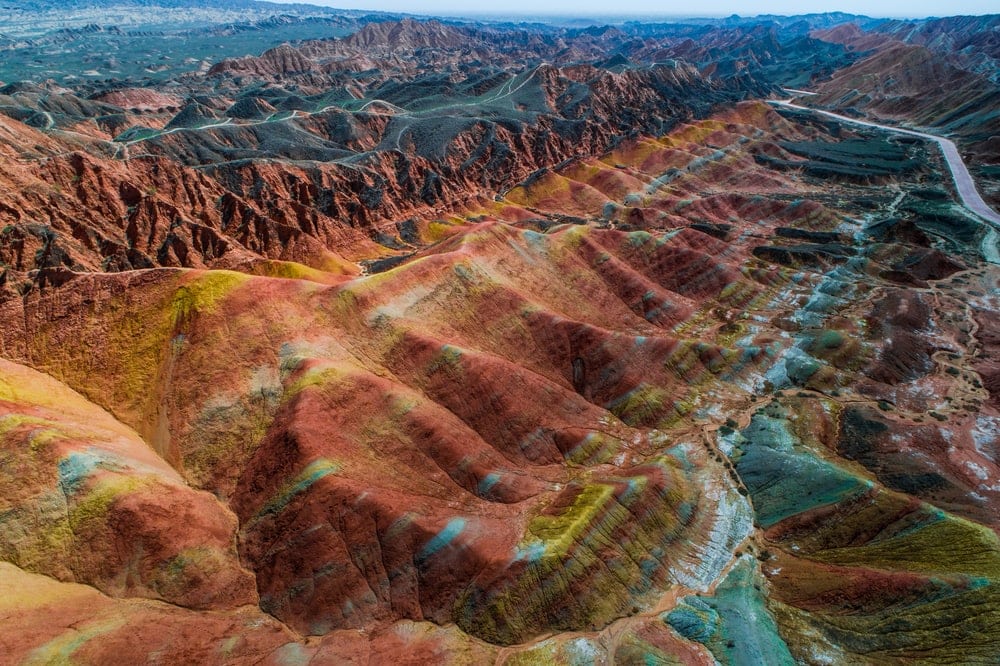
As defined by National Geographic, a landform is a "characteristic on the Earth'south surface that is part of the terrain." The terrain of the land includes all of its topographic features. Whether a formation sticks out of the footing or sinks into it, it has topographic significance.
Accept you always looked out of your window or driven past the same countryside in your home town and idea there wasn't annihilation special about it? After this article, you volition want to call up over again.
Land is similar a history book of the earth. When you know how to read it well, it tells you all kinds of stories about its by. Knowing how to read information technology takes time, just like whatsoever other language. When you acquire, it opens your eyes to the significance and brilliance of all those formations around you lot.
There are iv major types of landforms, although we added one more to the section beneath. At that place are four that are accepted throughout the scientific community. These include mountains, plateaus, hills, and plains. Everything else can fall into these broad and full general categories.
There are hundreds of minor landform typologies. Some of them are well known, like valleys. Others y'all have probably never heard of since they merely belong to particular geographic regions.
For example, an "uvala" is a type of elongated terrain and more all-encompassing than virtually types of sinkholes. An uvala is only establish in Croatia, Bosnia, Slovenia, Herzegovina, Montenegro and Serbia.
Before we expect at some of these lesser-known but just as interesting types of landforms, allow'due south dig deeper into the nigh significant landforms.
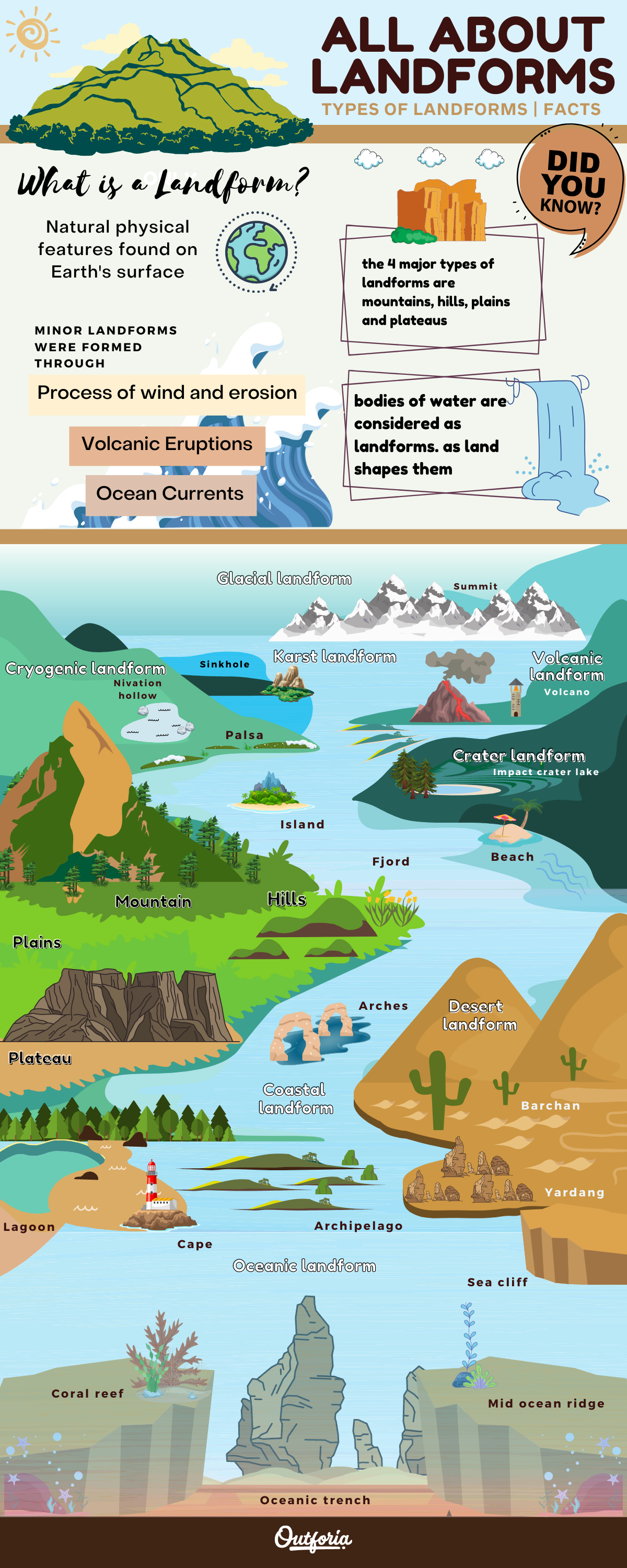
Share This Epitome On Your Site
<a href="https://outforia.com/types-of-landforms/"><img mode="width:100%;" src="https://outforia.com/wp-content/uploads/2021/06/Types-of-landform-infographic.png.png"></a><br>landforms Infographic by <a href="https://outforia.com">Outforia</a> 1. Meaning Types of Landforms
Mountains, hills, plateaus and plains are the 4 recognized significant types of landforms. They are known by almost everyone, whether you take an interest in geography or not. The reason for this is their commonality. You can find them all over the world in many different biomes.
In that location are plenty of minor landforms that you lot can find on, in, or nearby these five. Nevertheless, these embody vast swaths of land.
Whether or not you lot demand to know a lot about geography, it'due south skilful to sympathise these five landforms. Permit's have a quick trip around the world to observe examples of all of these landforms.
1.1 Mountains
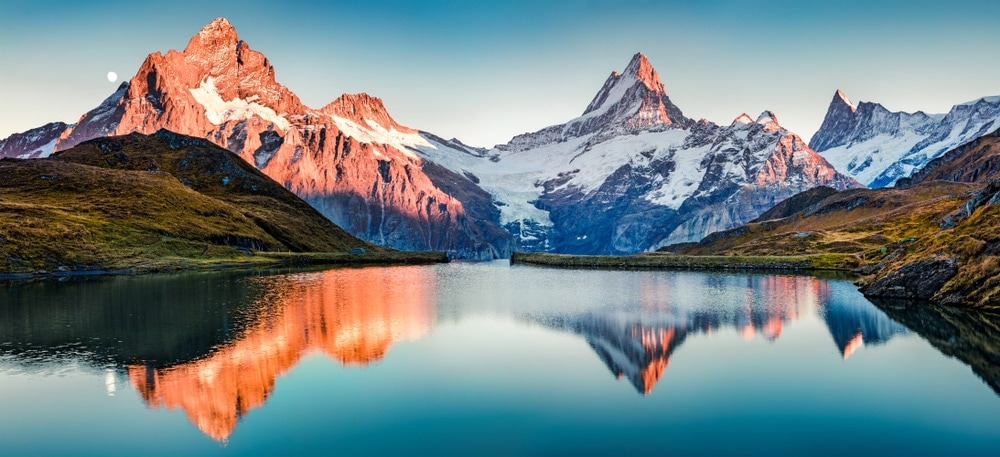
Mountains are easily recognized equally a landform because of their size and range. Mountains are frequently people'south favorite kind of landform because of their stunning beauty, whether looking at them or down from them.
What classifies a mount? Mountains take steep slopes that lead up to a superlative, a landform we discuss afterward in the article. For most geologists, a mount is any landform that rises one,000 feet (300 meters) or more in a higher place the surrounding area.
At that place are other factors, like its gradient and ocean level height, that geologists also have to consider to allocate a mount. Those are the main factors before it starts to get much more scientific.
Mountains are non only found in ranges that reach the sky. You can also find them on the ocean flooring. Some of the tallest mountains ascent from the depths of the ocean.
These be considering of the way that mountains get formed. Tectonic plates are the leading players in the formation of mountains. The unabridged surface of the earth's crust is tectonic plates. These plates are solid country that we all live on that slowly motion over the asthenosphere. The asthenosphere is the lava that is underneath the land.
These plates motion very slow. Even though it's slow, they cause significant disturbances on the earth'due south surface as they move. Sometimes they caused natural disasters, like earthquakes, volcanic eruptions, and flooding. Other times, they are barely noticeable.
The vast mount ranges we have today formed millions of years agone. When tectonic plates pushed hard against each other, they shoved country upwards. They formed many of the significant mountain ranges we have today.
Not every single mountain formed this way, just many of them do stick to that formation story.
Examples of Mountains and Ranges Throughout the World
Let's start with the ranges of mountains and then intermission out some of the well-known examples of mountains globally. The major mountain ranges we take today include:
- Himalayas
- Andes
- Rocky Mountains
- Alps
- Appalachian Mountains
- Ural Mountains
- Karakoram
- Sierra Nevada
- Atlas Mountains
- Pyrenees
- Dolomites
Every bit you become more familiar with mountain ranges, you will discover yourself able to identify them in photos. Each mountain range occurred on its own and has dissimilar kinds of mountains and geological deposits.
Our following listing includes the most famous or tallest mountain from each 1 of these ranges.
- Mount Everest (29,032' / 8,848 chiliad)
- Aconcagua (22,842' / 6,962 thou)
- Mount Elbert (fourteen,429' / iv,297 m)
- Mont Blanc (15,777' / 4,808 one thousand)
- Mountain Mitchell (6,684' / two,037 grand)
- Mount Narodnaya (6,217' / 1,894 chiliad)
- K2 (28,251' / 8,611 k)
- Mount Whitney (14,505' / four,421 thousand)
- Toubkal (thirteen,671' / 4,167 m)
- Aneto (11,168' / three,405 m)
- Marmolada (ten,968' / 3,343 grand)
There are other famous mountains throughout the world likewise. These include examples like Mount Kilimanjaro, Mount Fuji, Denali and the Matterhorn. The interesting thing about several of these is their standalone nature. Each of these rises out from low ground around it, barring the Matterhorn.
Another reason that mountains can be famous is their cultural significance. Mountains are oft role of folklore in the surrounding region, and their snowy tops concord a lot of mystique for many of those living in their shadows.
i.2 Hills
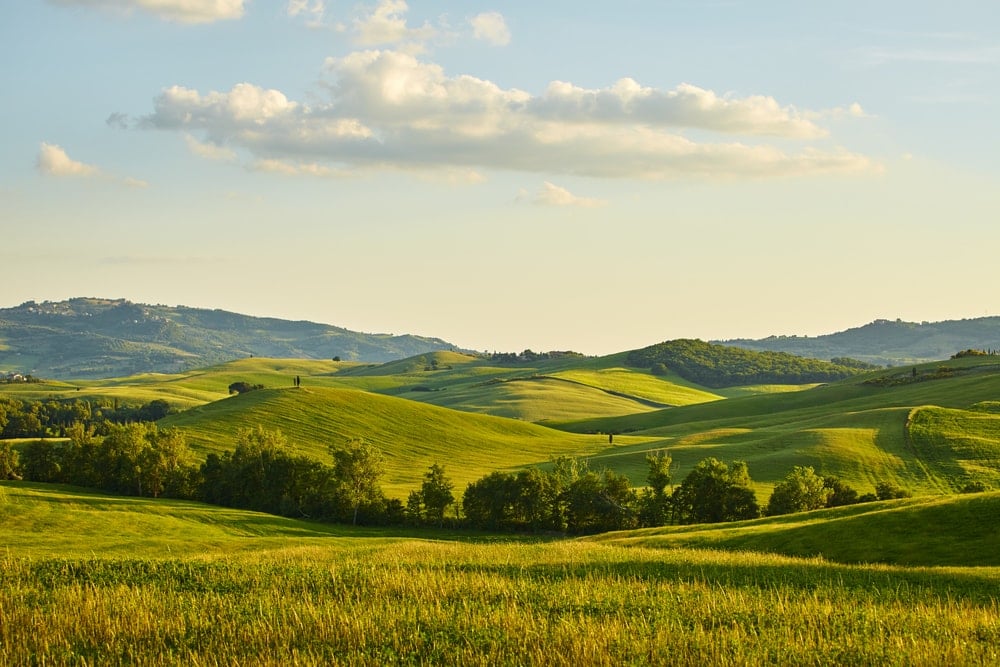
In a fashion, hills are like tiny mountains. They share many of their characteristics with mountains. For example, hills have to take a higher peak than the land around them. They can also form through tectonic activity. All the same, erosion is another actor in the formation of hills more than mountains.
Hills are smaller than mountains and are as well not every bit steep. Although the heights of some hills might be close to some small mountains, their gently sloping nature prevents them from beingness a mountain.
Areas that accept rolling hills are pretty pop regions of the world. They are cute without being arduous. For example, parts of California are filled with gently rolling hills and are widely popular.
Some of the more famous hills in the globe include:
- Chocolate Hills (Philippines)
- Ananthagiri Hills (India)
- Tuscany Hills (Italy)
- Glastonbury Tor (England)
Individual hills that are famous, similar Glastonbury Tor, have more to exercise with their history than their geographical interest. The Tor was where Richard Whiting, or the last Abbot of Glastonbury Abbey, was killed with 2 monks.
In that location are myths surrounding the hill and its terraced sides that appointment back to King Arthur and fascinating sections of Celtic mythology. Many of the historical remains on and in the loma remain unexplained to this solar day.
1.3 Plains
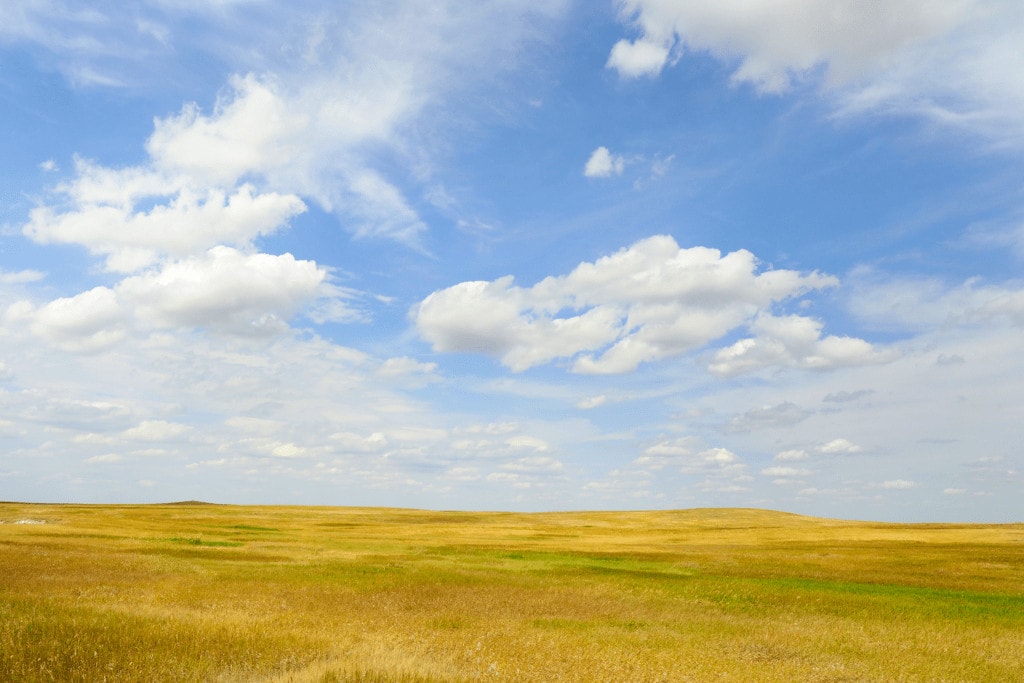
Plains are kind of the opposite of mountains and hills. They are flat expanses of state with very little topographical change. There are high and low plains, depending on how and where they are formed.
Plains might not seem as attractive equally the variation found in hills and mountains. Withal, they are incredibly vast expanses that take upward a big portion of the state above sea level. In total, plains cover over 19 1000000 square miles of land.
There are many ways that plains tin can class. They might exist there considering of the erosion of hills or mountains. They could likewise exist present because of a lava flow that stale and became fertile millennia later.
Yous can find examples of plains from large to small all over the world. Some of the more than common examples of plains include:
- Corking Plains (Us) – 1,100,000 square miles
- Canterbury Plains (New Zealand) – 195 square miles
- Australian Plains – 2,966,200 square miles
- Serengeti Plains – xi,583 square miles
- European Plain – two,000,000 square miles
- West Siberian Plain (Russia) – 1,200,000 square miles
- Indus Valley Apparently (Pakistan) – 200,000 square miles
Plains are valuable because of the biodiversity they support. They are typically the home for big herds of animals such as buffalo, zebra, and wild horses, depending on where they are.
i.4 Plateaus
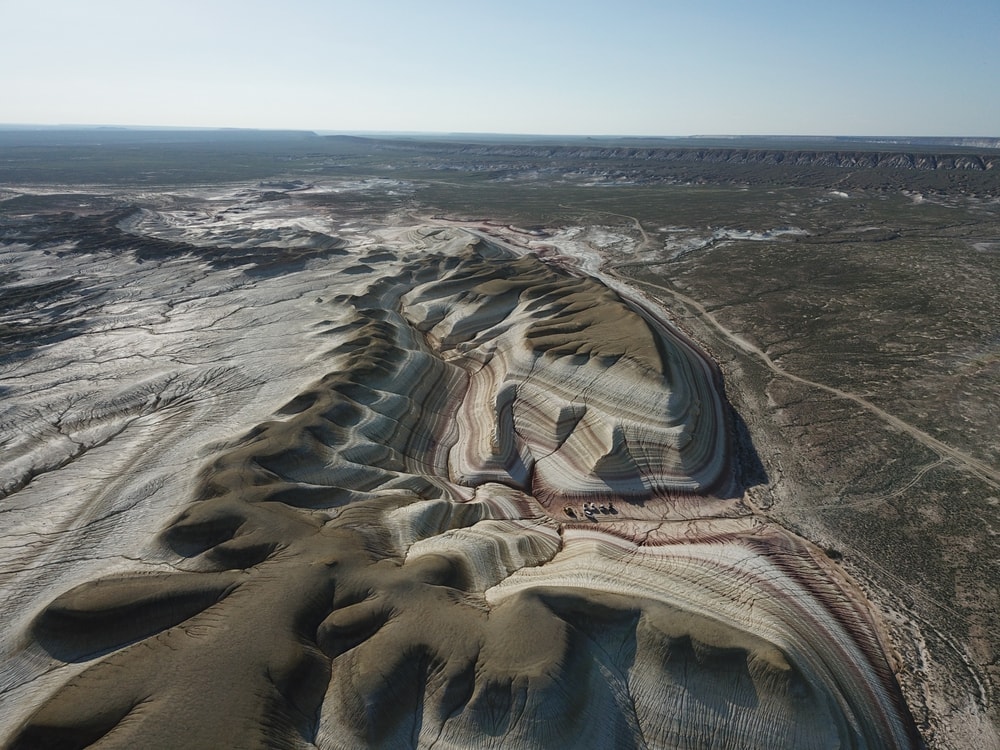
Plateaus used to be considered elevated plains but are now distinctive enough in their nomenclature and number that they are dissimilar. A plateau is an elevated and primarily apartment area of country with a edge on at least one side with lower-lying country.
One of the theories on the formation of plateaus is that they are ancient mountains whose summit levels and summits eroded downwardly over time. They now bridge hundreds of thousands of miles across sure parts of the earth. Typical formations you might see on them include buttes, mesas, and canyons.
Some of the more than extensive plateaus on the globe include:
- Mongolian Plateau – ane,000,000 square miles
- Colorado Plateau – 240,000 square miles
- Tibetan Plateau – 970,000 foursquare miles
- Mexican Plateau – 232,488 square miles
At that place are many hundreds of smaller plateaus scattered throughout the world. Since they are oft caused by erosion, their sizes change each twelvemonth, some more than noticeably than others.
2. Dissimilar Types of Minor Landforms
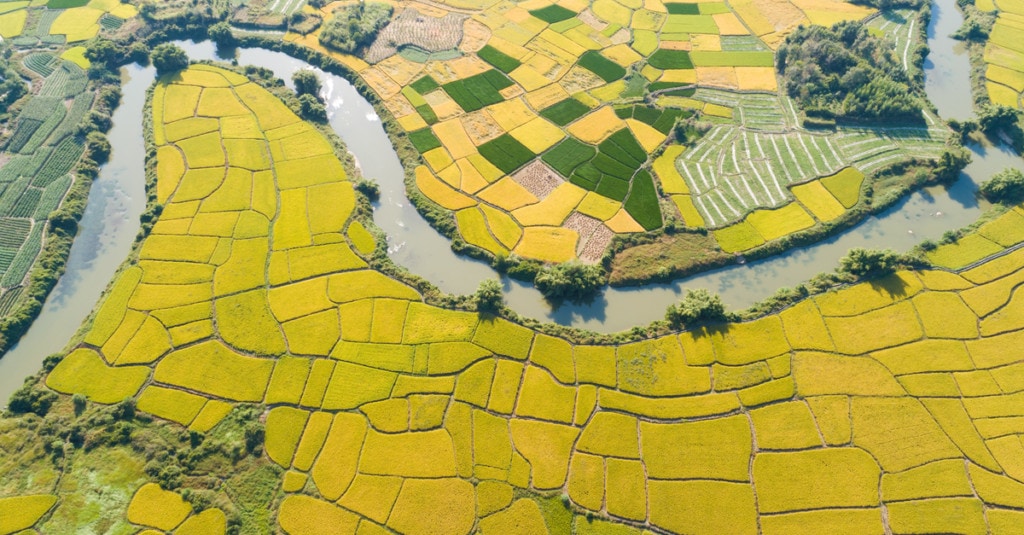
Beyond the 4 major landforms, there are hundreds of small landforms spread across the globe. These were formed in all kinds of wondrous ways, whether through processes of wind and water erosion, ocean currents, or volcanic eruptions.
Some of them are in specific biomes, and some kinds have less to do with their shape and more than to practice with the kind of material they include.
We take produced a list of the major types of landforms underneath the category of "minor landform." These are in the same group according to how they formed and the biome in which it happened.
From examples of desert landforms to volcanic landforms, we have got it all. Under each subheading, we include features of three to nine examples of landforms. These are the types nosotros deemed about heady or most necessary to know inside the category. We as well include a list of the other types of landforms that exist in the subcategory.
2.ane Aeolian or Desert Landforms
Deserts aren't landforms so much as they are a biome. They do include plenty of unique landforms, though. Nigh of these have formed through the erosive forcefulness of the wind. That is where nosotros get the name "Aeolian." Aeolus is the Greek god of wind. An apt name for desert landforms if yous ask us.
Featured Aeolian Landforms
2.1.1 Dry Lake
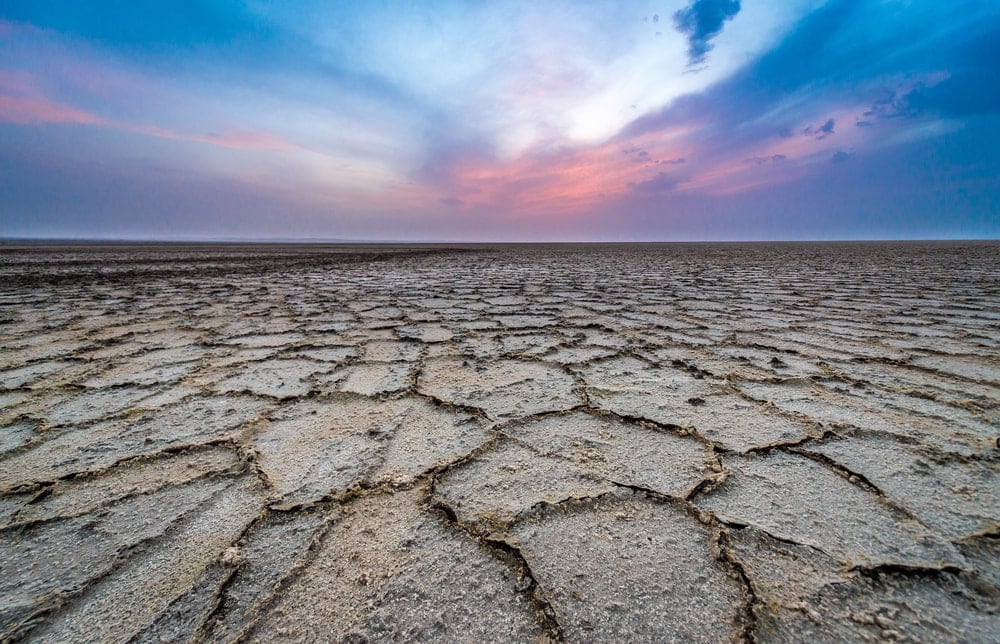
Another proper noun for a dry out lake is a "playa." A dry lake is a depression or basin-similar germination in the earth that had previously independent a continuing surface body of water. When information technology becomes a dry lake, it ways the water has all disappeared.
A dry lake forms considering evaporation exceeds the process of recharge, either from ground reservoirs below or precipitation. It typically denotes a change in the biome around it. There could have been desertification of a lush area at ane bespeak in history.
Examples of a dry lake include Namak Lake in Iran and the Sailing rock in Racetrack Playa. There are quite a few sprinkled throughout the deserts of the world. If the bottom of the lake bed is covered in alkalines, you might also call it an "alkali apartment."
2.1.2 Yardang
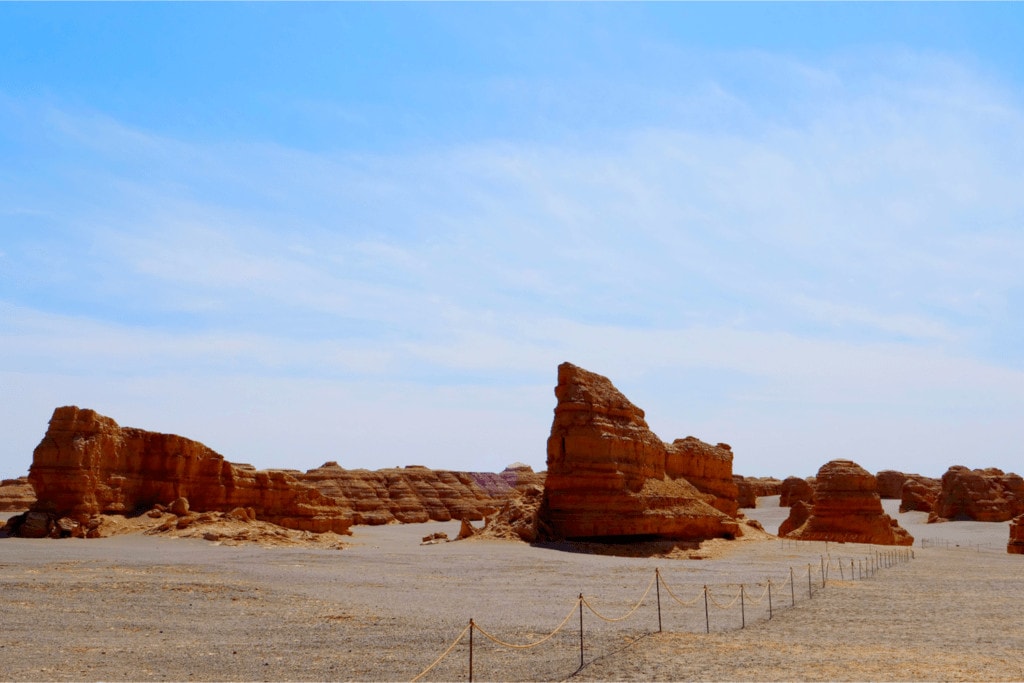
A yardang isn't only a funny word; it'due south a visually fascinating landform. Yardangs class because of excessive amounts of air current wearing away bedrock in one direction and consolidating materials on summit of each other. It's this dual-activity procedure that forms towers of stone that lean in ane management.
A yardang doesn't have a detail shape, but they are typically a pillar of rock that seems to lean and "point" in the direction the current of air blows.
There are mega-yardangs in the central Sahara desert near the Tibesti Mountains. There are quite a few notable land formations throughout Arizona that are likewise yardangs.
2.1.3 Barchan
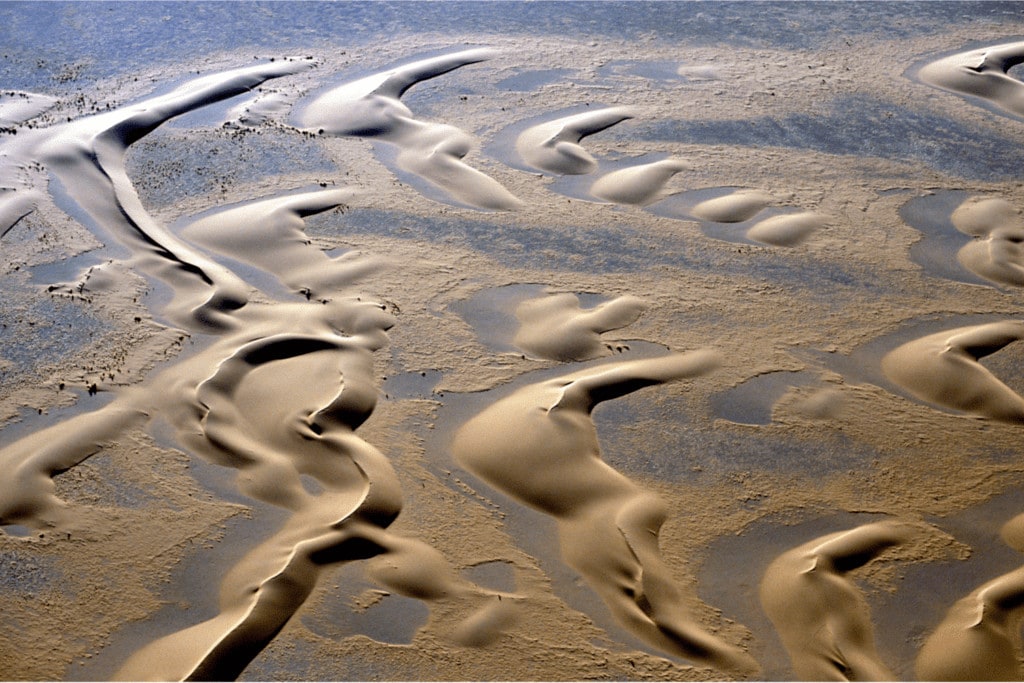
A barchan or barkhan is a specific type of dune. They are again formed by the current of air in a specific way to give them visual interest. Russian naturalist Alexander von Middendorf commencement used the term "barchan." He was describing the dunes he found throughout Turkestan.
A barchan is a crescent-shaped dune. They announced to exist convex from sure angles but are concave on the leeward side. They class when there isn't as much loose sand on the surface, and the current of air blows in a unmarried direction until the sands stockpile. The sand ends upwardly avalanching down the unstable skid face up to grade the crescent shape.
2.1.4 Other Types of Aeolian Landforms
- Blowout
- Desert Pavement
- Desert Varnish
- Dreikanter
- Dune
- Erg
- Loess
- Sandhill
- Ventifact
2.2 Coastal Landforms
Nigh of us already know what coast is, the land found at the border of the ocean. There are different kinds of coasts all over the world. They include white sand beaches, steep cliffsides, and rocky shorelines.
A coastal landform has a lot to exercise with the currents of the ocean. Sure materials get pushed upwardly until the shoreline to form some of the landforms. The ocean water eats away at some shorelines, and wind erosion still plays a big role in them.
There is quite a bit of our coastline that nosotros can credit to tectonic plate activity. Underwater volcanoes grade some landforms. Nosotros take featured some of all different kinds below and included an extensive list of the rest underneath that.
Featured Coastal Landforms
2.ii.1 Curvation
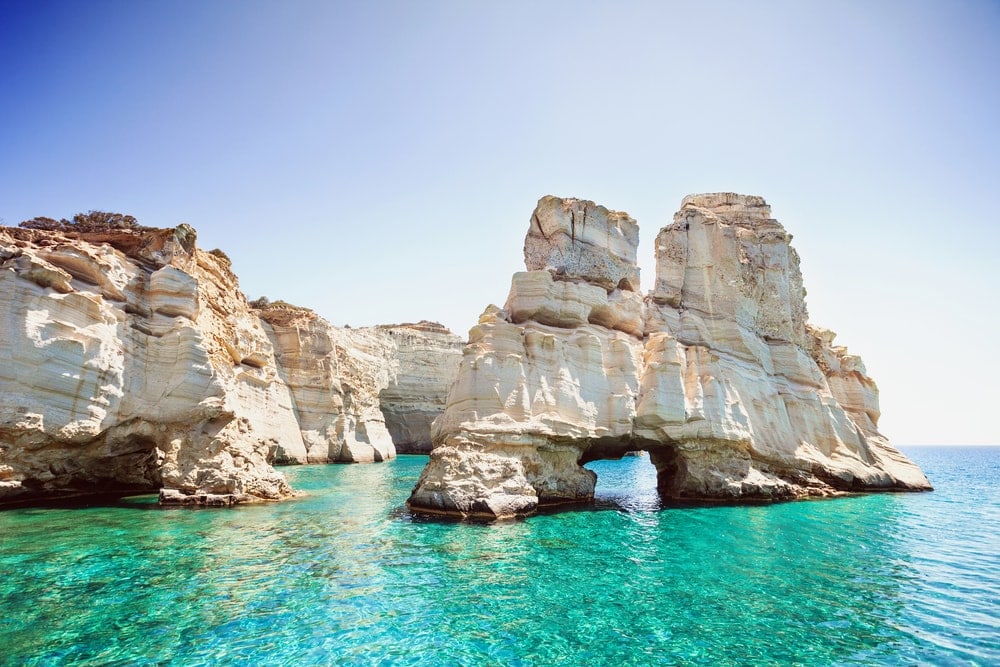
Coastal arches, or ocean arches, are formed when tall rock formations stick out from an elevated portion of the coastline. They are at least partially in the water, which means the sea goes to piece of work on information technology.
As the ocean waters bite abroad at the stone, portions that are weaker erode. Eventually, they can grade a large arch in the rock, forming a channel through which the water passes.
These arches can exist rather large and majestic. You have probably seen one of them on the screensavers we mentioned at the beginning. Some of the most incredible ocean arches worldwide include the one at Kleftiko Beach, Great Pollet Curvation, Hopewell Rocks, Honopu Arch, and Pigeon Rocks.
2.ii.ii Archipelago
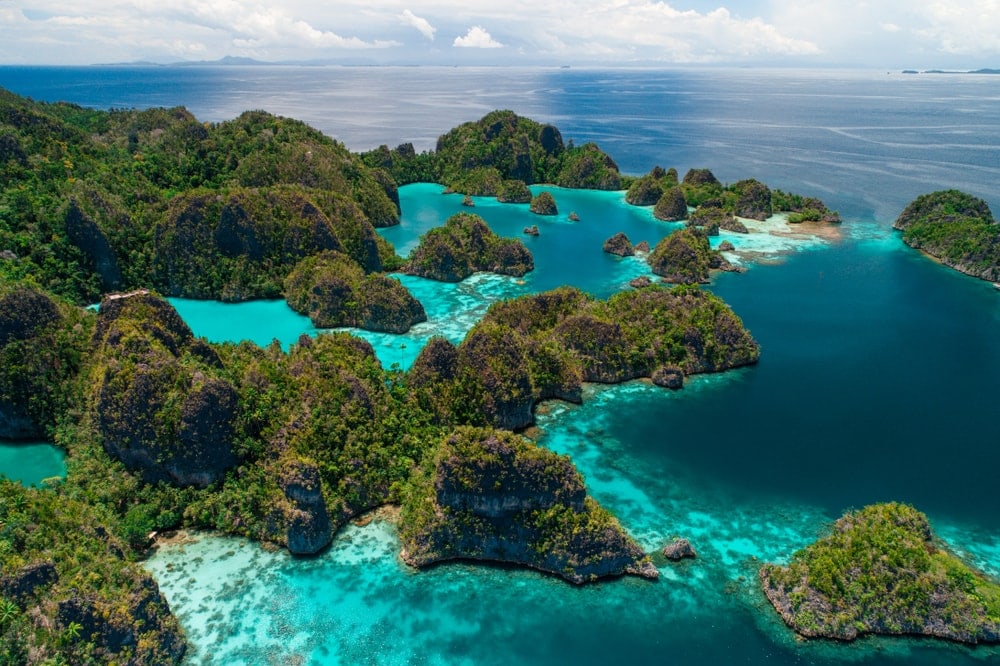
An archipelago is a fascinating coastal landform and a good 1 to know if you study geography. An archipelago is a group of islands that are close enough to all exist considered ane unit of measurement.
Archipelagos form when the ocean'southward current transports sediment on acme of a coral reef until information technology stacks up large enough to stack upward out of the water. Many times, it takes the aid of a tectonic movement to push the islands far plenty in a higher place ocean level to make them livable.
Some of the nigh famous archipelagos include the Florida Keys, the Indonesian Archipelago, the Maldives, the Bahamas, and the Azores. In other words, they are great places to vacation.
Some are in colder areas. Due to a lack of coral reefs in cold waters, these often course more like mountains pushed out of the water or sinking of the lower country. These include the Canadian Chill Archipelago and the British Isles.
ii.2.iii Beach
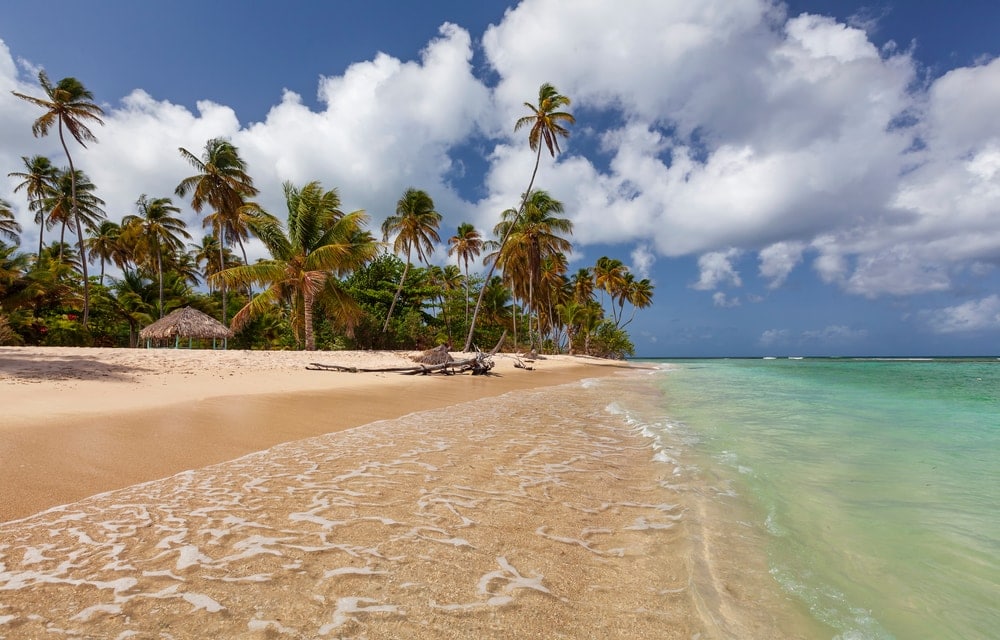
A embankment is a narrow strip of land that separates a water body from inland regions. Yous will typically discover beaches next to every bounding main, even if simply a couple of inches. There are beaches for rivers, lakes, and oceans.
Beaches are formed by h2o movement, slowly stripping the land of topsoil until it has a gentle slope. The current then deposits all kinds of materials. "Nice" beaches are often deposits of sand. Others will take pebbles and seashell fragments.
Almost of the beaches that are considered the best in the globe are close to the equator. These include Pigeon Point in Trinidad and Long Beach in Vietnam.
2.2.4 Cape
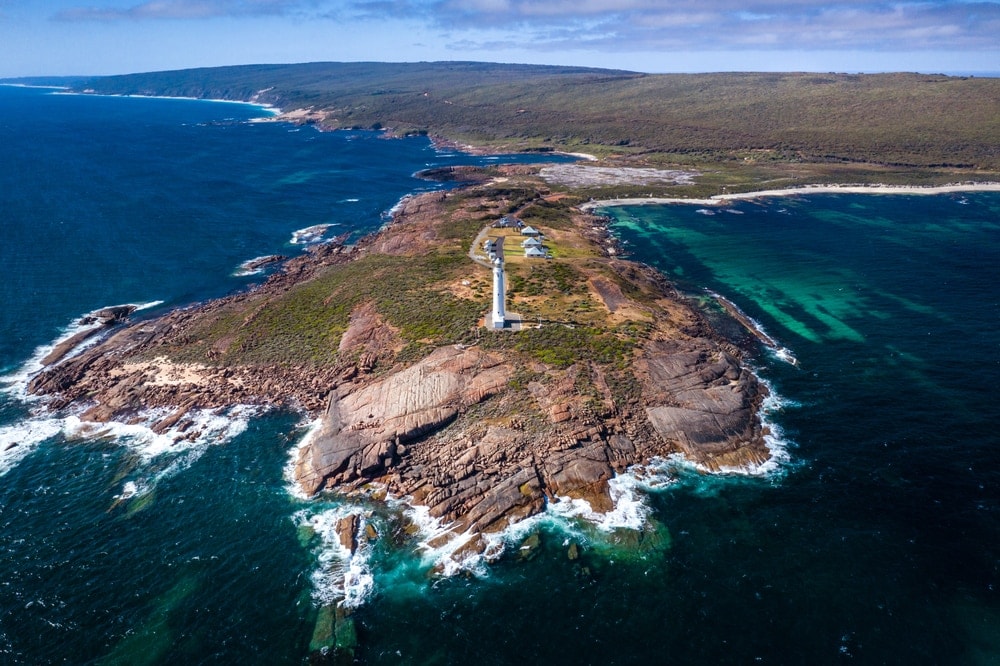
A greatcoat is oft a more prominent coastal landform, although it doesn't have to be. It's a high strip of state that extends out into a water body like a lake or ocean. Some capes connect to the master landmass in the region. Others are a part of an island that sticks away from the more massive island body.
A germination similar to a cape is a peninsula. 1 of the primary differences is that a peninsula makes upward a large portion of a mainland unit of measurement. Florida is a peninsula since it's so large and connected solidly to the larger body of the mainland United states of america. Greatcoat Hatteras in North Carolina is smaller and a part of islands in contrast.
2.2.v Fjord
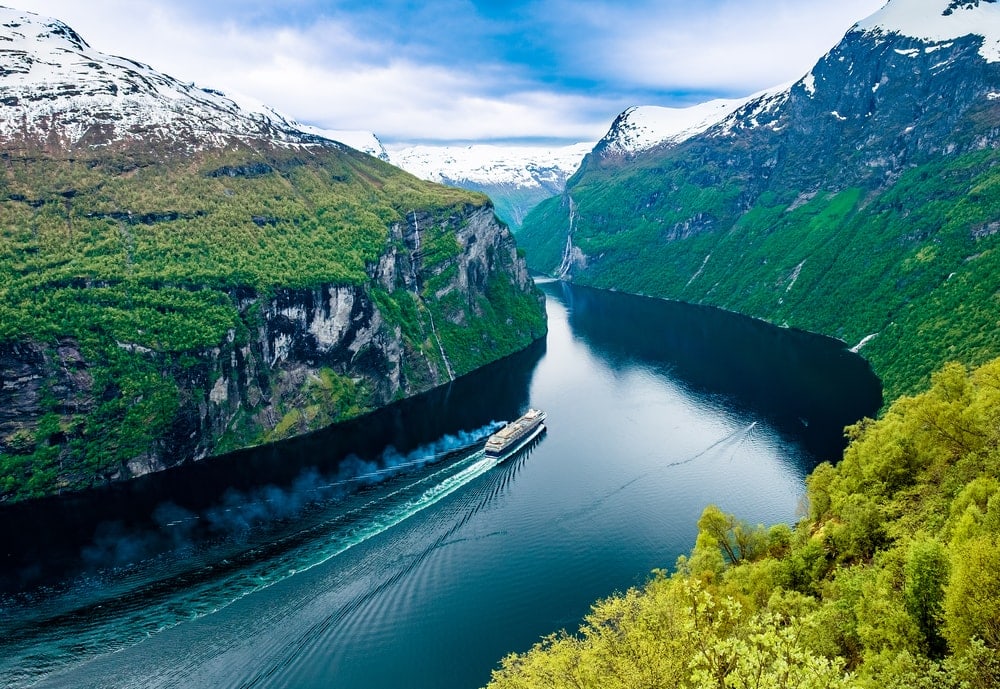
Nearly of usa know the word fjord from Norwegian culture. Norway and Iceland do have a mural total of them, only you can also observe them in Canada and Russian federation.
A fjord is a narrow, deep, long inlet between the body of water and high cliffs. A fjord forms when a glaciated valley becomes submerged. After the glacier carves its mode into part of the coastline, the sea, ocean, or other water bodies fill in behind it.
Fjords are typically stunning. There are famous fjords in Patagonia, Republic of chile, the Misty Fjords in Alaska, the Westfjords in Iceland, and the Sognefjord in Norway.
two.ii.6 Island
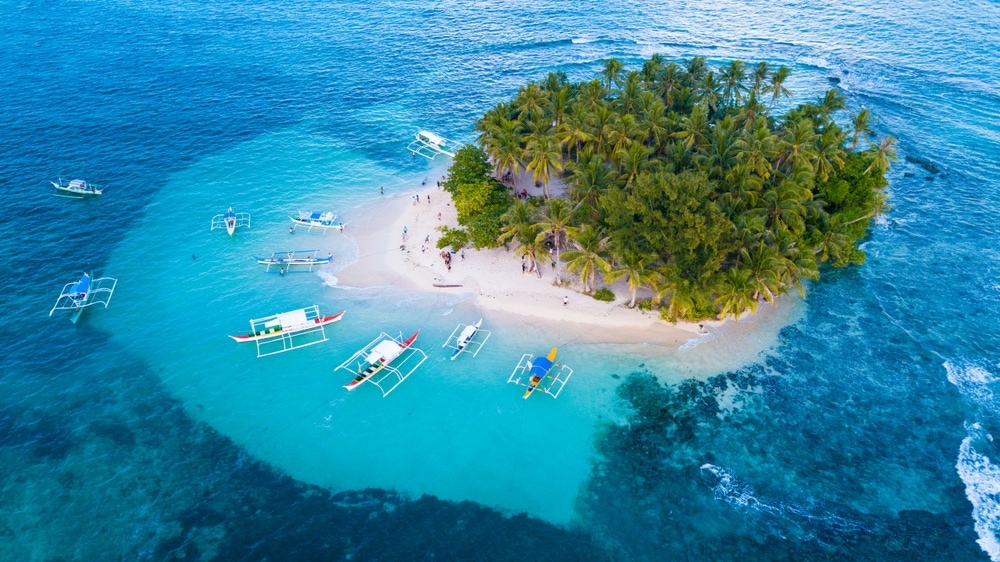
Islands are pieces of land surrounded by water. They can range from pocket-sized blips with a couple of trees on top to massive pieces of land, like England and Ireland.
Islands course in all kinds of ways. They might take been coral reefs at one point pushed out of the water. There are also underwater volcanoes that grade islands when they erupt, and the lava cools towards the surface.
Hawaii has a series of famous islands. There are too islands off Japan and Korea, and Indonesia is mostly islands for the virtually part.
2.ii.vii Isthmus
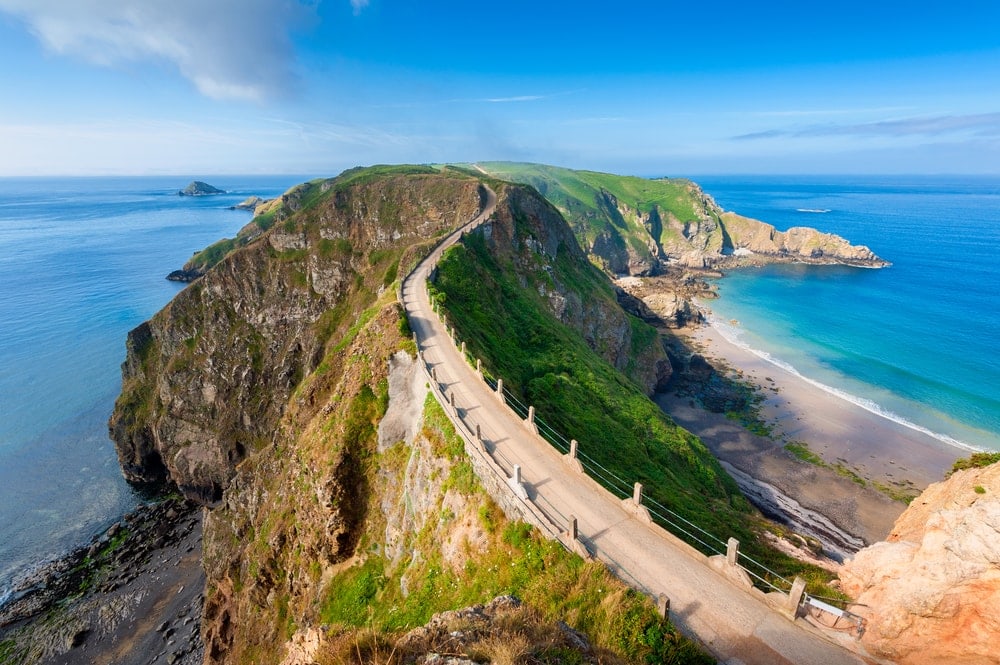
An isthmus is a narrow strip of country that has water on either side of it. They connect two pieces of land that are typically much larger, although they can also connect small-scale islands.
An isthmus forms by a portion of country either sinking or rising from the ocean.
The two most famous isthmuses include the Isthmus of Panama and the Isthmus of Suez. The Isthmus of Panama serves to connect North and South America. The Isthmus of Suez connects Africa to Asia. Both of these are of vital importance geographically and historically.
2.2.8 Sea Cliff
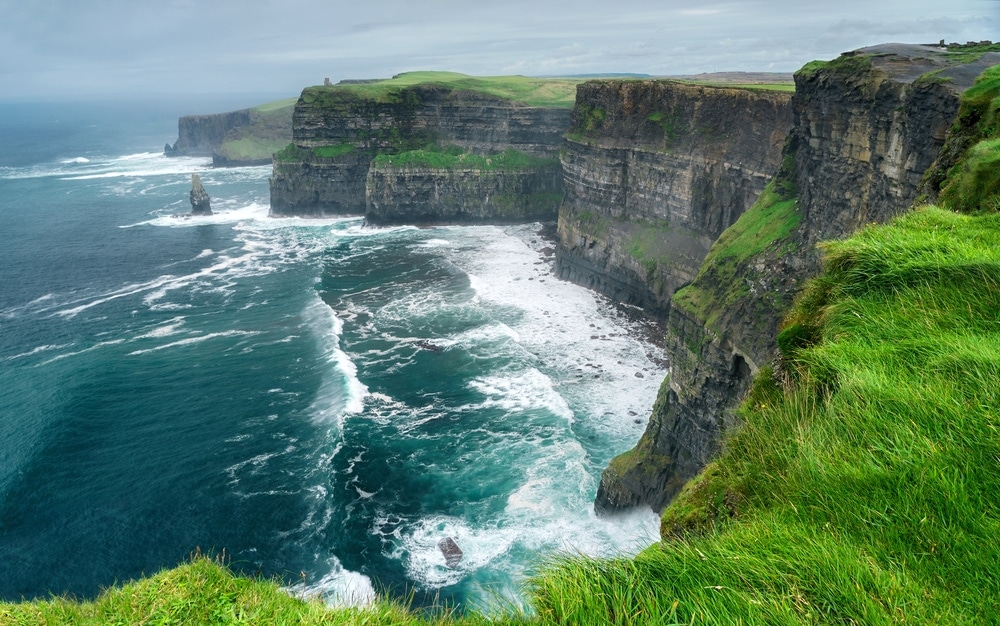
In contrast to a beach, you tin likewise have sea cliffs running along a coastline. Sea cliffs are steep faces of soil and rock formed and eroded past waves. They crash confronting the cliffside until the lower layers fall abroad and a notch forms.
Inevitably, the rest of the basis becomes unstable. Information technology will cease up collapsing, and then the body of water has access to all new layers of the cliff. Sea cliffs proceed to retreat until they reach harder rock or eventually reach the lower ground.
You want to be very careful at the end of a ocean cliff for this reason. Although you might exist standing far above the body of water, that doesn't mean you are safe from it. Examples of famous body of water cliffs include the cliffs of Moher in Ireland, the Kalaupapa Cliffs in Hawaii and Preikestolen in Norway.
2.2.9 Other Types of Coastal Landforms
- Ayre
- Barrier bar/barrier isle
- Beach cusps
- Beach ridge
- Bight
- Blowhole
- Calanque
- Coast
- Cove
- Cuspate foreland
- Dune system
- Firth
- Fjard
- Headland
- Machair
- Marine terrace
- Peninsula
- Sea cave
- Shoal
- Shore
- Suge channel
- Moving ridge cut platform
3.1 Oceanic Landforms
Beyond the incredible landforms found at the border of the ocean, there are plenty that reside in the ocean itself. The ocean is an effector of enormous change on the planet. Approximately 71% of the Globe'due south surface is covered in water, with the oceans holding well-nigh 96.5% of this water.
Ocean currents are powerful and highly repetitive acts. They serve to hack abroad at and build up all kinds of landforms. Water e'er runs to the oceans as well, causing all kinds of landforms to course so water tin get at that place. Other factors in oceanic landforms include tectonic motility, like always, and volcanic activity.
Featured Oceanic Landforms
3.1.i Coral Reef
A coral reef is an underwater structure composed of millions of skeletons of colonial marine invertebrates. Each slice of coral is a polyp. Polyps live on the calcium carbonate concentration in the exoskeletons of the generations that came before them.
A coral reef is i of the few landforms fabricated upwardly of colonies of living creatures. They are the building blocks of so many other kinds of landforms likewise. As reefs form and dice, so practise islands, beaches, and sand bars.
The most famous coral reef is the Great Barrier Reef off the coast of Commonwealth of australia. In that location are also beautiful coral reefs in the waters of the Northern Hawaiin Islands.
3.1.2 Lagoon
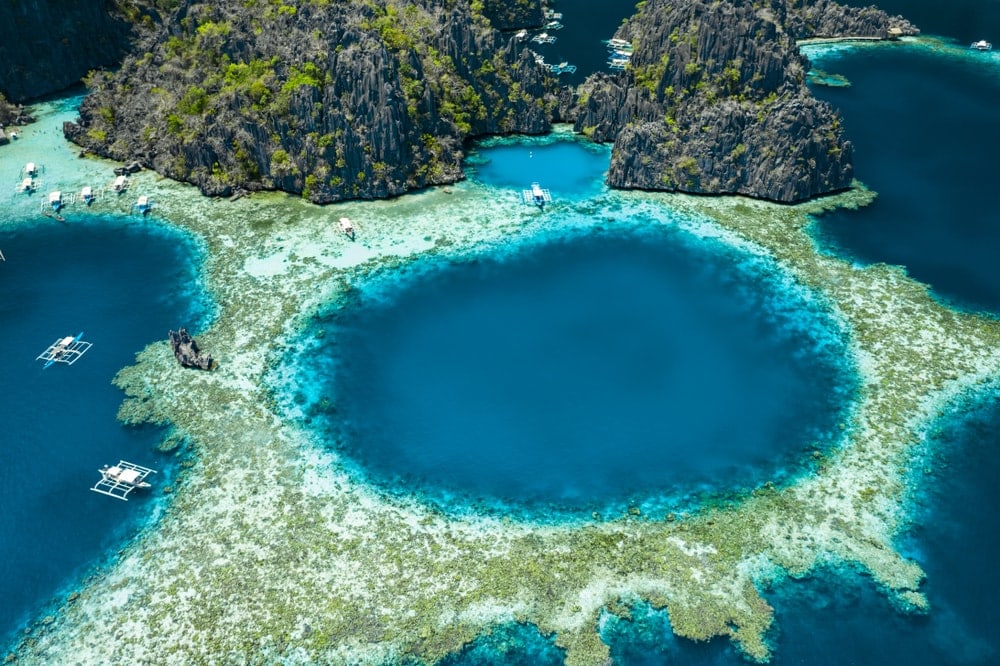
A lagoon is a smaller body of water that has been separated from the large water body by a sandbank or a coral reef. They can be both freshwater and saltwater, depending on what their female parent h2o torso was.
Lagoons are formed in dozens of different ways by a variety of natural phenomena. Some of the virtually famous ones include the Nanuya Levu in Fiji and the Blue Lagoon in Iceland. Both of these are trendy tourist destinations for their beauty.
3.ane.3 Mid-ocean Ridge
A mid-bounding main ridge is a ridge system that rises from the ocean bowl at random. They are typically formed by seismically active tectonic plates causing an incredible push up from the sea's depths or a division between two plates, causing a deep canyon.
The nigh famous mid-sea ridge is the Mid-Atlantic Ridge. This ridge because of the spreading action of the two tectonic plates that come across in the Atlantic Ocean. They spread further apart each year. Thus, this rift is known equally a "spreading heart."
three.1.4 Oceanic Trench
An oceanic trench is a deep, steep low that occurs in the deepest part of the ocean. They are enormous and relatively unexplored. Many theorize at that place could exist all kinds of unknown species that live at these depths of the bounding main.
Oceanic trenches grade when one tectonic plate pushes into and underneath another plate. Ane side rises while the other pushes down lower and lower. They eventually grade volcanoes all along the seafloor and vast oceanic mountain ranges.
Some oceanic trenches include the Tonga Trench, the Due south Sandwich Trench, the Mariana, and the Philippine Trench.
3.one.5 River Delta
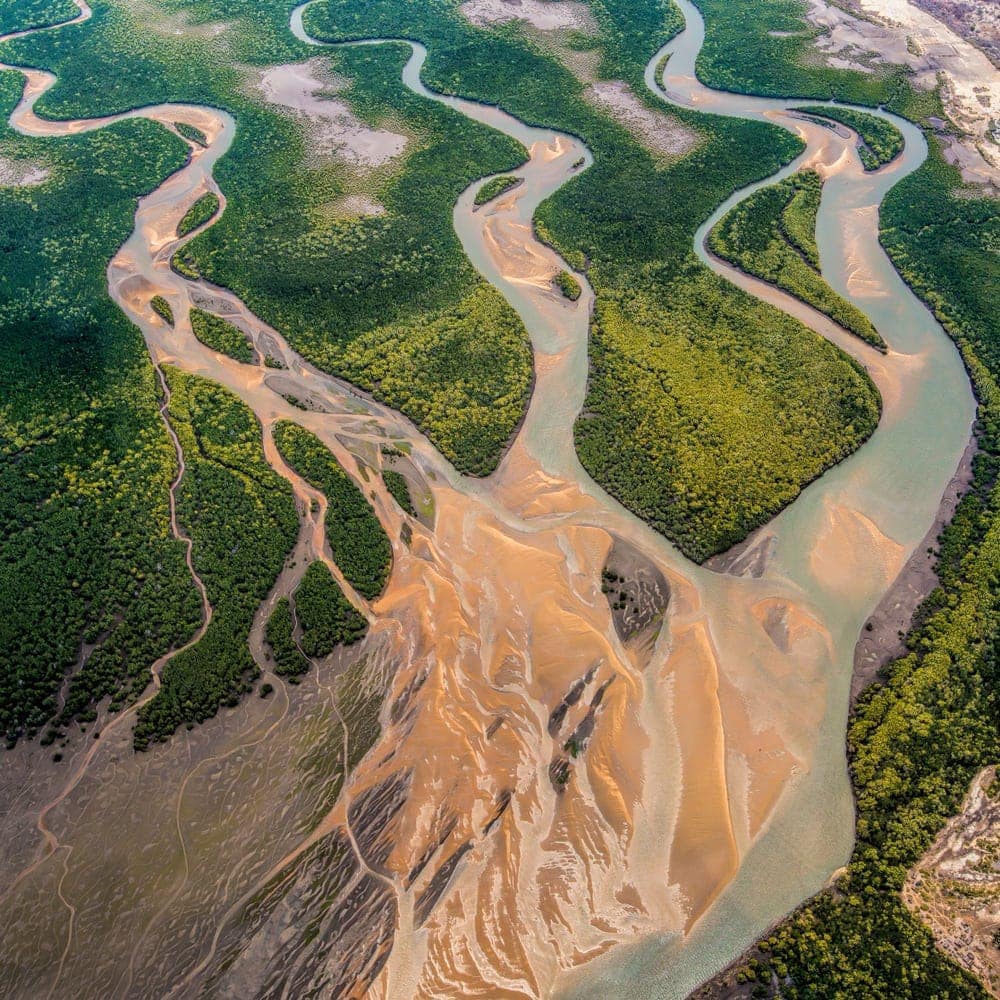
Allow'due south bandage our gaze outside of the depths of the ocean for a minute. Water that falls on land and into lakes and rivers always moves back towards the ocean. Sometimes, as information technology gets closer to these large bodies of water, it forms a river delta.
A river delta is a landform that is a degradation of sediment. The river carries this sediment and leaves it at the mouth of an expanse of slower-moving or fifty-fifty stagnant water. Information technology forms a sort of triangular shape with all kinds of rivulets running through it.
Famous examples of a river delta include the Amazon Delta, the Euphrates Delta, the Godavari Delta, and the Indus River Delta. Although yous can't tell much on peak with the delta, from above, they are incredible and intricate landforms.
three.1.six Other Types of Oceanic Landforms
- Abyssal fan
- Deep-sea plain
- Atoll
- Bay/gulf
- Channel
- Continental shelf
- Estuary
- Inlet
- Islet
- Oceanic bowl
- Oceanic plateau
- Ria
- Saltmarsh
- Seamount
- Spit
- Strait
- Submarine canyon
4.one Cryogenic Landforms
The word "cryogenic" is frequently used concerning something that is very, very common cold. In a cryogenic landform, it's a mass of land or topographical development in a very cold biome. You lot will find almost of these but located in the Antarctic and the Arctic.
Almost cryogenic landforms are formed considering of the atmospheric condition and the cycles of deep cold and cook these areas feel.
Featured Cryogenic Landforms
4.i.one Lithalsa
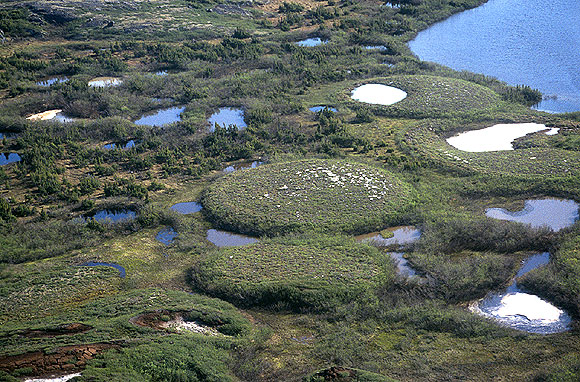
group of well-developed palsas / lithalsa
A lithalsa is a frost-induced slice of raised land that develops in permafrost areas that have mineral-rich soil. They occur where a perennial ice lens develops in the soil.
A lithalsa is often virtually a perfect circle in the mural. There are non many of them, and they alter around due to the atmospheric condition and soil content. That ways there aren't whatsoever that you can go and find since they are a weather condition-dependent landform.
4.1.ii Nivation hollow
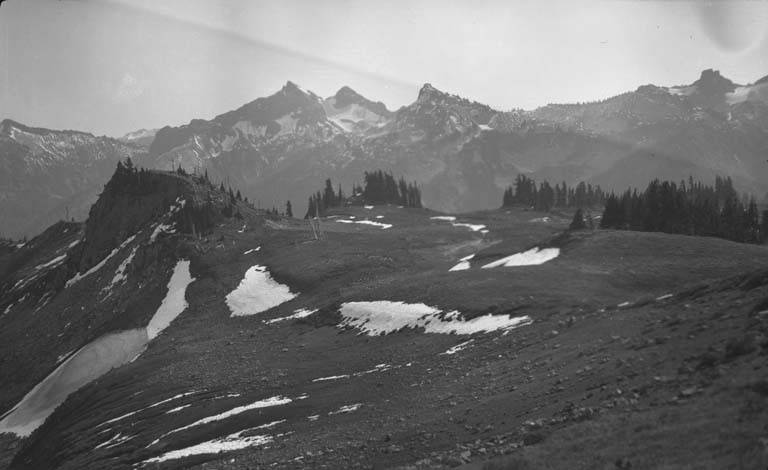
Nivation hollows typically occur on the side of a mountain. They are shallow depressions in the mountain gradient that is either permanently or intermittently filled with snow in a bank or a patch.
Nivation occurs considering of erosion that happens under and to the side of a snowbank. Typically, nivation happens considering of alternating freezing and thawing. Nivation hollows are not very permanent features and tin can typically be found on tall, snowy mount sides.
4.i.iii Pingo
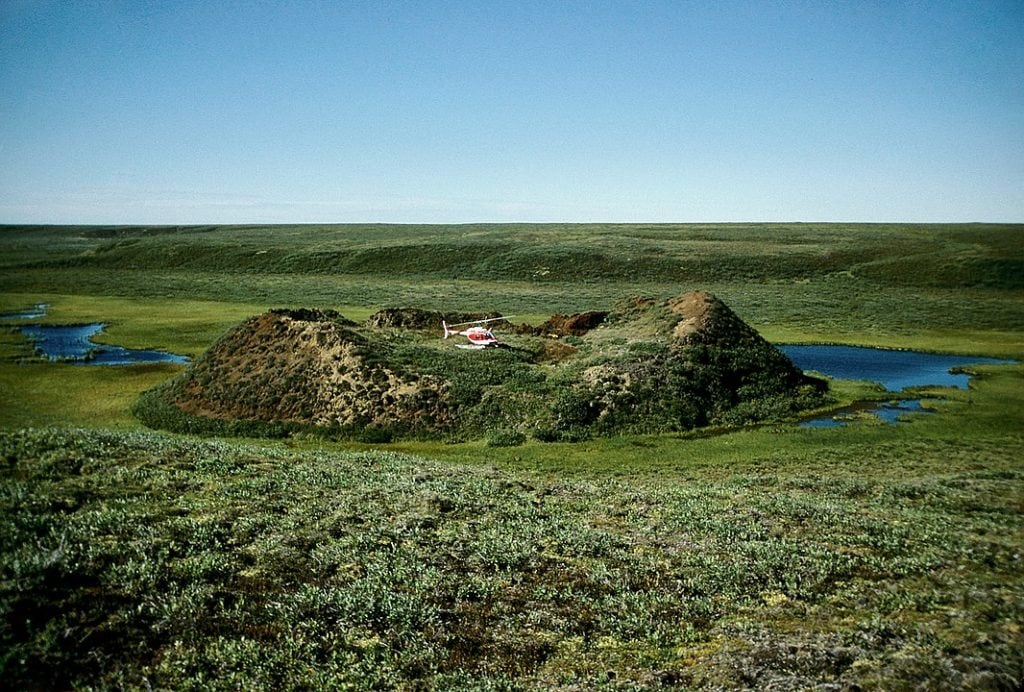
Collapsed pingo in the Mackenzie Delta
A pingo is a mound of soil in a dome shape covered by a core of ice. Information technology typically happens in permafrost areas. The most remarkable examples of pingos are in Central Asia. Here, there are pingos at the highest elevations in the world. The Tibetan Plateau contains pingos at 13,000' (4,000 m) above sea level.
4.i.four Rock glacier
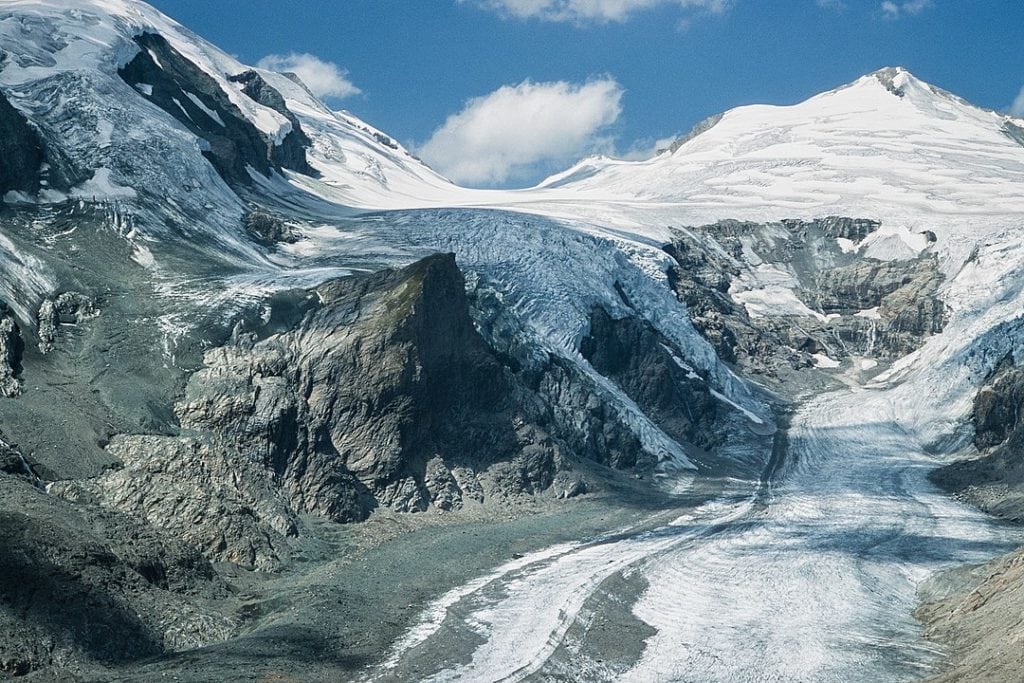
Grossglockner Glacier in austria
At that place are ii examples of a rock glacier. Ane is a periglacial glacier, and another is a glacial rock glacier. They are both primarily made of masses of rock, snow, mud, and ice. They end upwardly slowly moving downwards a mountain considering of gravity. A stone glacier might also be a mass of rock with interstitial ice.
Rock glaciers usually form when ice and snow melt over a talus slope. They end up melting into the rocks and freeze deep below the surface. They consequence in a massive corporeality of rocks all frozen together.
You tin find examples of stone glaciers in Utah, the Timpanogos Glacier. In that location are quite a few others, merely they are so large that they can be hard to identify as separate from a mountain face. Fun fact: in that location accept been some potentially identified on Mars past the Mars Orbiter spacecraft.
4.1.v Other Types of Cryogenic Landforms
- Cryoplanation terrace
- World hummocks
- Palsa
- Permafrost plateau
- Solifluction lobes and sheets
- Thermokarst
v.i Impact Landforms
Speaking of Mars and all things extraterrestrial, impact landforms form via extraterrestrial impact. When part of an asteroid or meteor makes contact with the globe's surface, information technology has quite a significant effect.
Featured Touch on Landforms
5.1.1 Complex crater
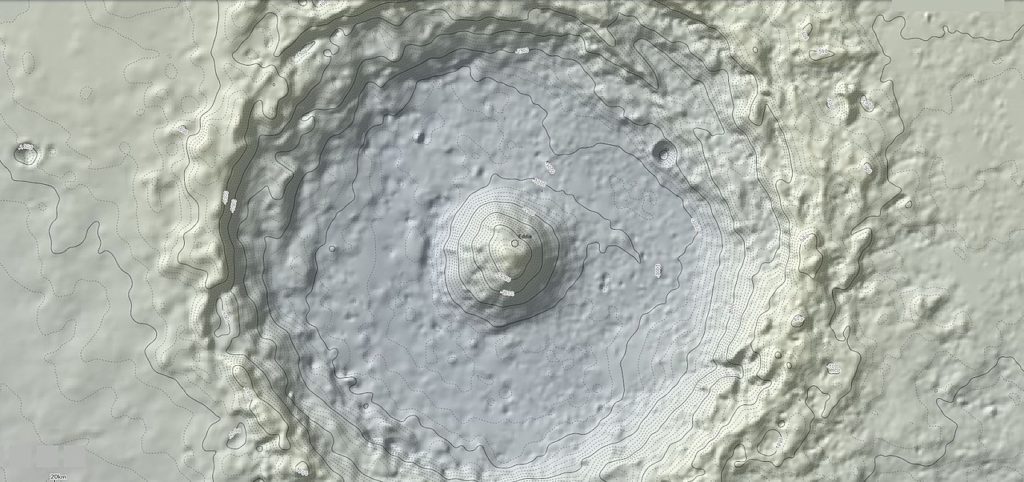
a primal height-band crater on Mars
A circuitous crater is a type of touch on crater that is quite large with multiple uplifted centers. When the affect first happened, its force and the underlying layers of the earth's chaff weren't able to accept on all of the forcefulness of the bear on in one surface area. The effect was the caving in and rising of several places throughout the site of impact.
5.i.ii Impact crater lake
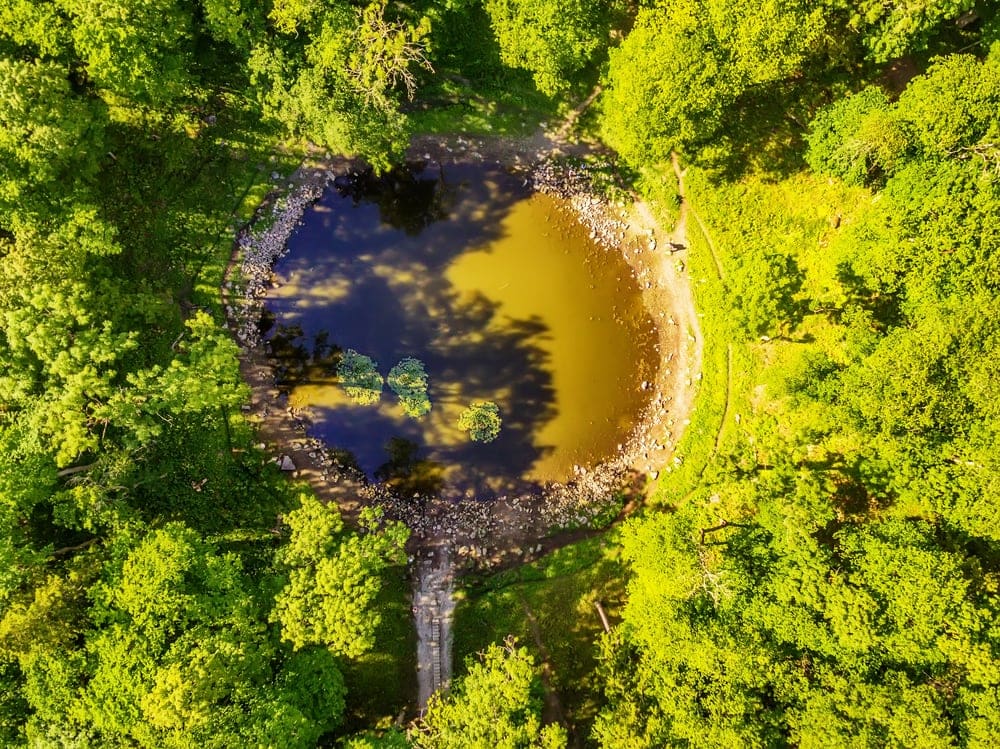
Impact crater lakes are much more than mutual than many of the other varieties of touch on landforms. Asteroids first created them, but then the processes on the earth'southward surface took intendance of the rest.
Typically, when an asteroid hits the earth, information technology's so hot that it speedily burns upwards and disappears or breaks apart. The initial touch typically forms a circle since wherever it hit volition be covered extensively in the form of the accident. At the edges of the impact area, the land will form ridges forming the crater.
Examples of crater lakes include the Clearwater Lakes in Quebec, Canada, Lake Acraman in Australia, and the Kaali Meteorite Crater Field in Republic of estonia.
5.1.3 Other Types of Touch Landforms
- Central height
- Cratered mural
- Bear on crater
- Simple crater
6.1 Karst Landforms
A Karst landform might besides be known as a type of mural. Information technology occurs when there is a field of dissolving bedrock shut to the top layer of soil. This dissolving layer of rock eventually forms landforms like sinkholes, caves, and sinking streams. Soluble rocks are typical to a Karst, such as marble, limestone and gypsum.
Featured Karst Landforms
6.ane.1 Cenote
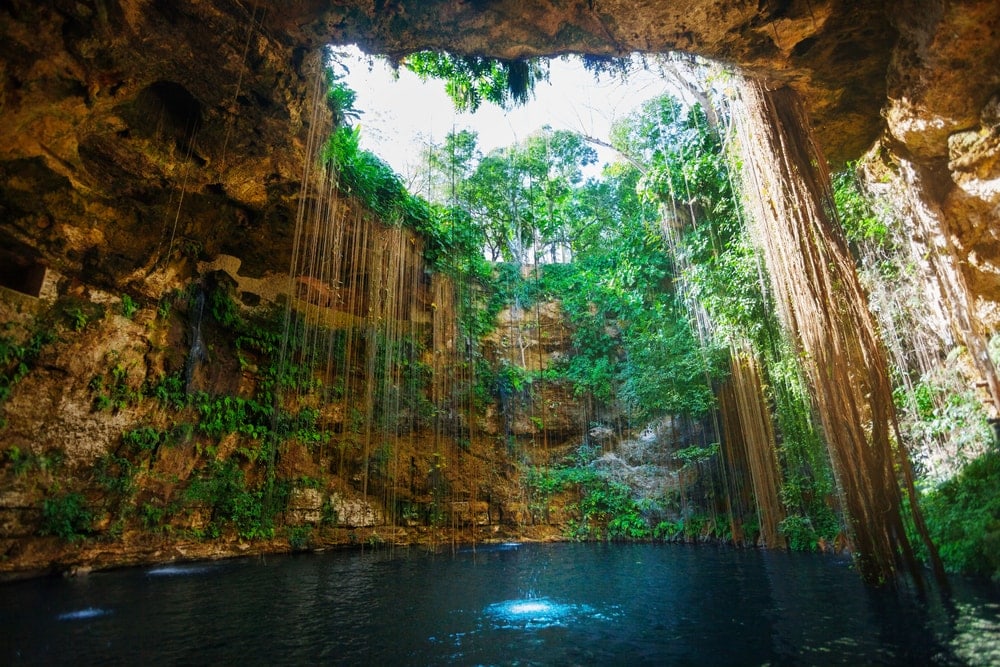
A cenote is a type of sinkhole typical of a Karst landscape. It's a natural pit that results considering of the plummet of limestone. Information technology exposes groundwater below it. There might be a big cave underneath the complanate rock, or it might only be a small indention.
Some examples of famous cenotes occur in Mexico. These include the Dos Ojos in the Yucatan Peninsula and the Ik-Kil Cenote in Chichen Itza. Cenotes provide stable environments for species that need controlled temperatures and water movement.
Swimming in a cenote is a touristy activity, but information technology isn't recommended. For i, since a cenote is a pigsty in the topsoil leading into a large cavern, it can exist tough to make it and out of. What's more, yous will destroy the biology of the place if you swim with any creams or excess oils on your skin since all types of plants and animals crave a pure and counterbalanced environment.
vi.1.2 Sinkhole
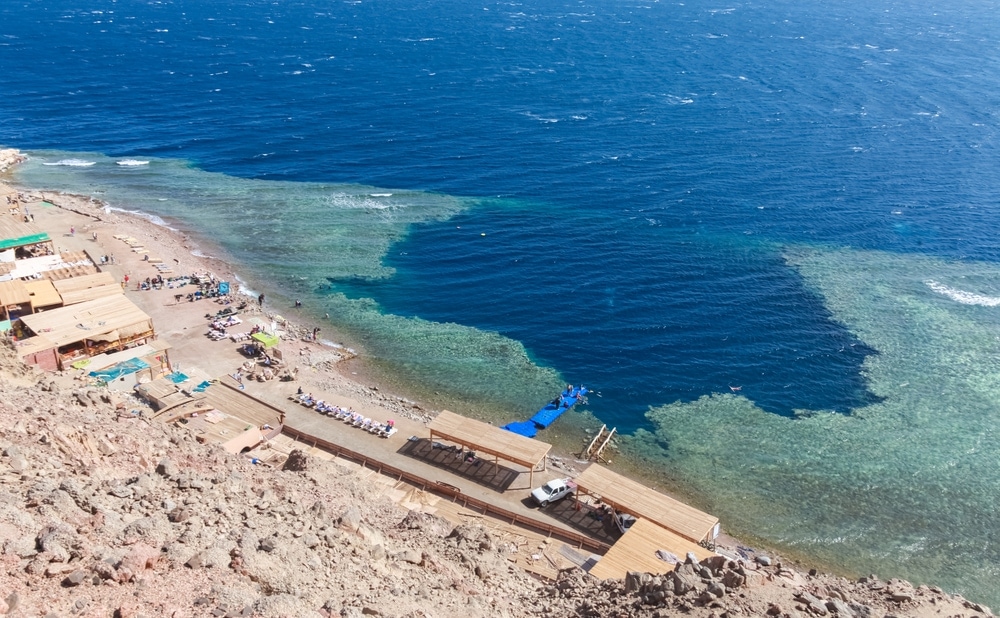
A sinkhole is a depression in the ground caused by the collapse of minerals and rocks underneath them. They are acquired by h2o on the surface eroding information technology, and dissolution of the stone from the groundwater below it.
In sure areas where sinkholes are common, they can exist pretty dangerous. If they haven't collapsed notwithstanding, there is no way you can know yous are walking over 1 until you autumn inside. Many people have died or gotten seriously injured by falling into sinkholes.
Famous examples of sinkholes worldwide include the Blue Pigsty in Dahab, Arab republic of egypt, the Boesmansgat in Southward Africa, and Lake Kashiba in Zambia. Florida's lagoons and forests are often littered with sinkholes that are only merely forming and require caution.
half dozen.1.3 Turlough
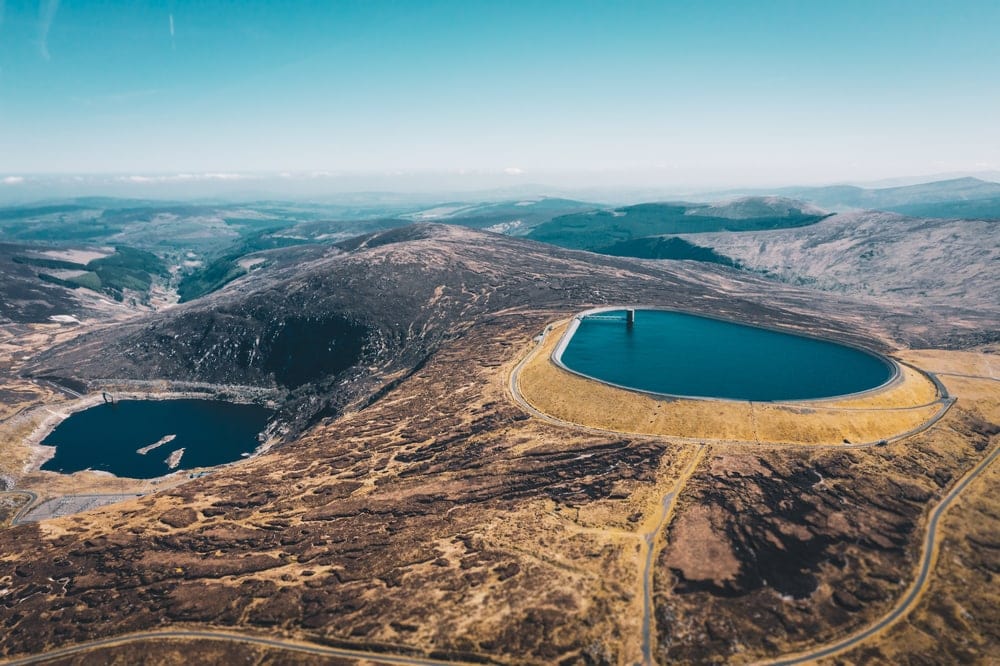
A turlough is a unique landform to Ireland, with one exemption located in England. These landforms are low-lying areas on top of limestone that get repeatedly flooded during wet weather. They well upwardly with groundwater and form a temporary lake or pond.
Turloughs are part of Celtic mythology. They were pretty mysterious for many years since they would randomly appear and disappear. Sometimes the areas are quite large. Imagine one day walking over a colina to a glittering lake and the next coming back to find only a valley among the hills.
six.1.4 Other Types of Karst Landforms
- Abime
- Calanque
- Foiba
- Karst fenster
- Mogote
- Polje
- Scowle
- Uvala
vii.i Mountain and Glacial Landforms
Other than the larger mountains and glaciers, there are many landforms that happen because of their movement and formation. Across the big motion-picture show of the mount, you lot will detect all kinds of unique landforms, sometimes effectually every bend when you lot dig into information technology.
Featured Mountain and Glacial Landforms
7.1.1 Canyon
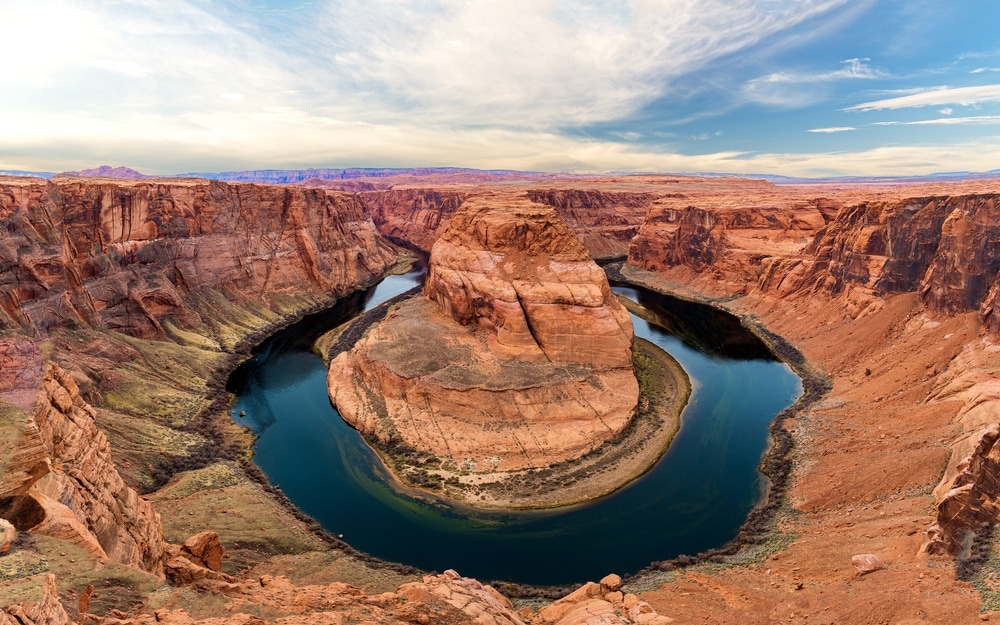
A canyon is a deep gorge between two larger rock formations. Normally, there is a river flowing through it, which as well plays a part in how canyons are formed.
A coulee is sometimes formed, at least in part, by moving glaciers cutting between the stone. Rivers come into it by eroding the canyons down even further.
An excellent example of a notable canyon is the G Canyon. At that place are many smaller ones scattered in all kinds of mountainous regions of the world or those that once had glaciers moving through them.
7.1.two Cirque
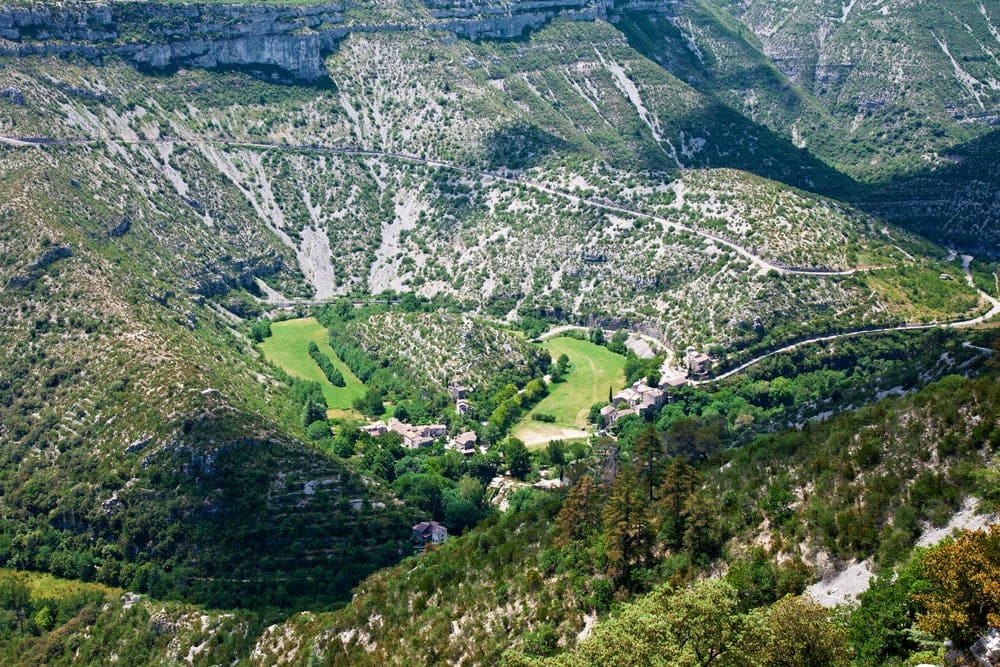
A cirque is another landmass formed by glacial erosion. It takes the shape of an amphitheater with a valley formed in between a semi-circle of high mountain sloops. Sometimes information technology'south gentle slopes and not extremely obvious, and other times these are enormous and incredibly steep natural amphitheaters.
There are large and pocket-sized cirques in well-nigh every mountain range in the world. If you have to hike in a fractional circle to get from one superlative to the next with a steep valley below you, then you are likely hiking around the ridge of a cirque.
seven.1.3 Hoodoo
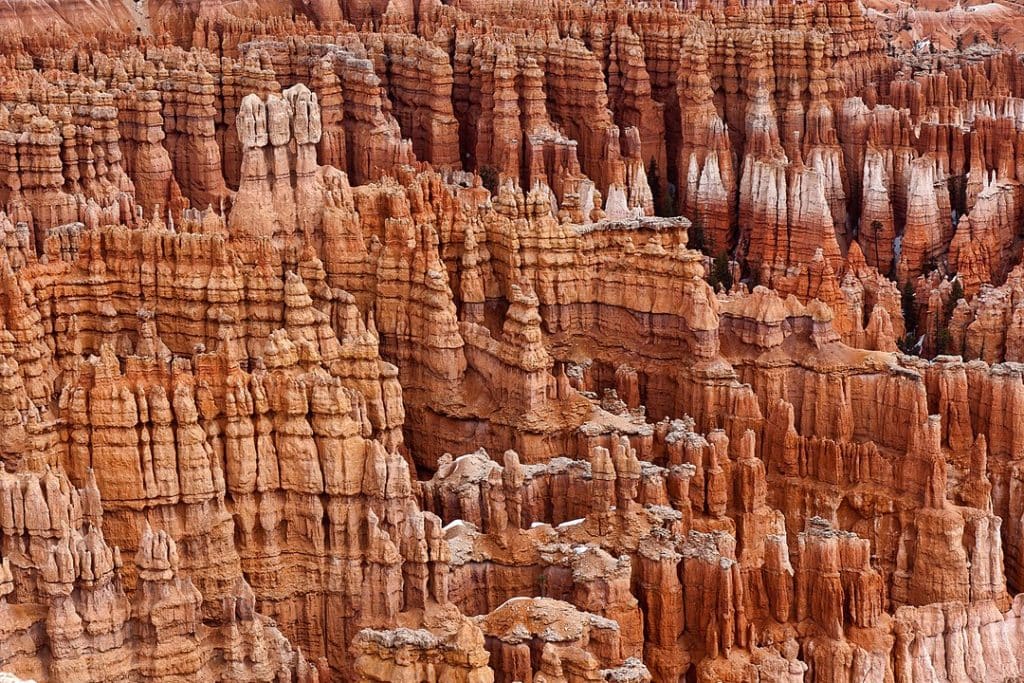
bryce coulee national park
A hoodoo is a column of weathered rock. Many times, hoodoos are formed by a combination of rainwater running over them and wind rushing between them.
The word "hoodoo" comes from Hausa, a language originally from West Africa that means "to agitate resentment". Because of the rising nature of the hoodoo and the eerie fashion it does it, it looked to settlers similar the land was rising for retribution. Hoodoos tin can likewise exist called "fairy chimneys."
Bryce Canyon National Park is i of the most well-known places on world for its hoodoo formations. An entire valley is filled with them. There are also many hoodoos scattered throughout United mexican states and Arizona besides as in certain parts of Africa.
seven.1.four Mesa
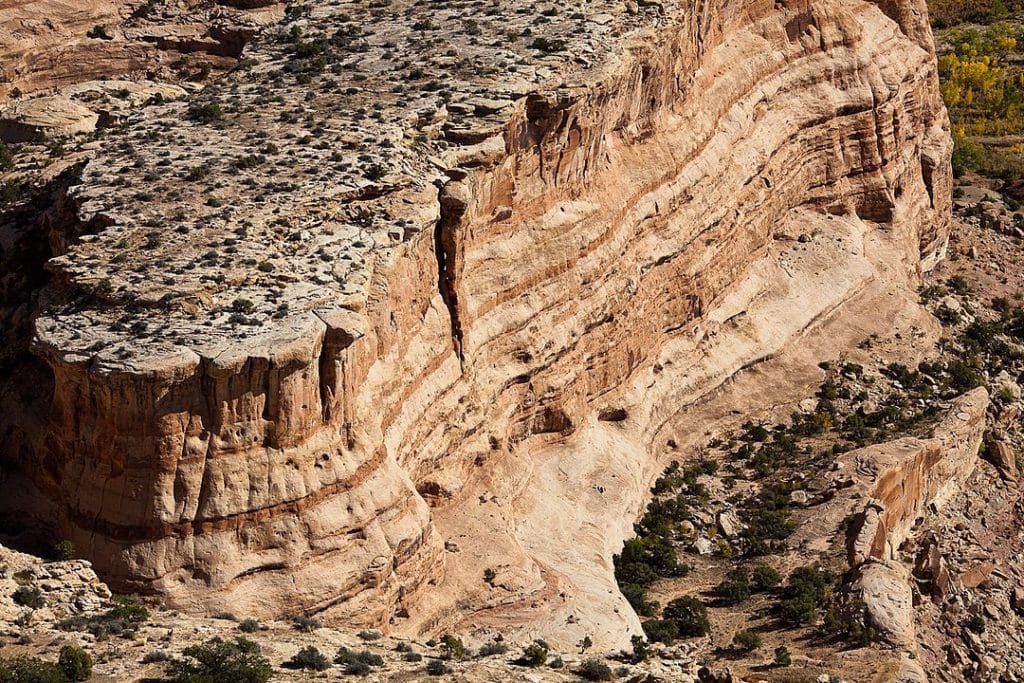
Mesa in the One thousand Canyon of the San Rafael
A mesa comes from the Spanish word for "table." Information technology describes a mountain or a hill with a distinct flat acme. On summit, they are quite wide with steep sides leading upwards to their increased acme, similar to a tabular array.
The name "mesa" was given to these landforms by Spanish explorers entering the American Southwest, where many of these landforms are. Throughout Arizona and New Mexico, they are scattered all over the parched landscape.
1 expert example of a mesa is Mount Conner or those landforms found throughout Canyonlands National Park.
7.1.5 Top
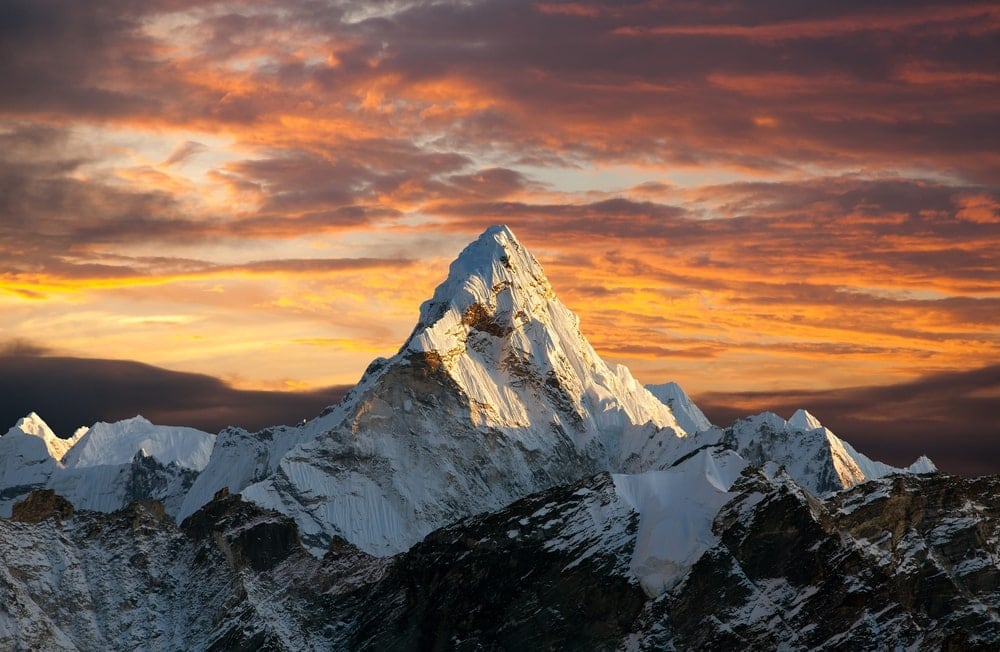
A summit of a mountain or elevated place is the highest point in elevation. Every mountain has a summit. Some of them are more gradual while others are distinct and offer a goal for mountain climbers.
It is hard for u.s.a. to requite you examples of famous summits since whatever famous mountain is likely to have a famous tiptop.
7.1.vi Valley
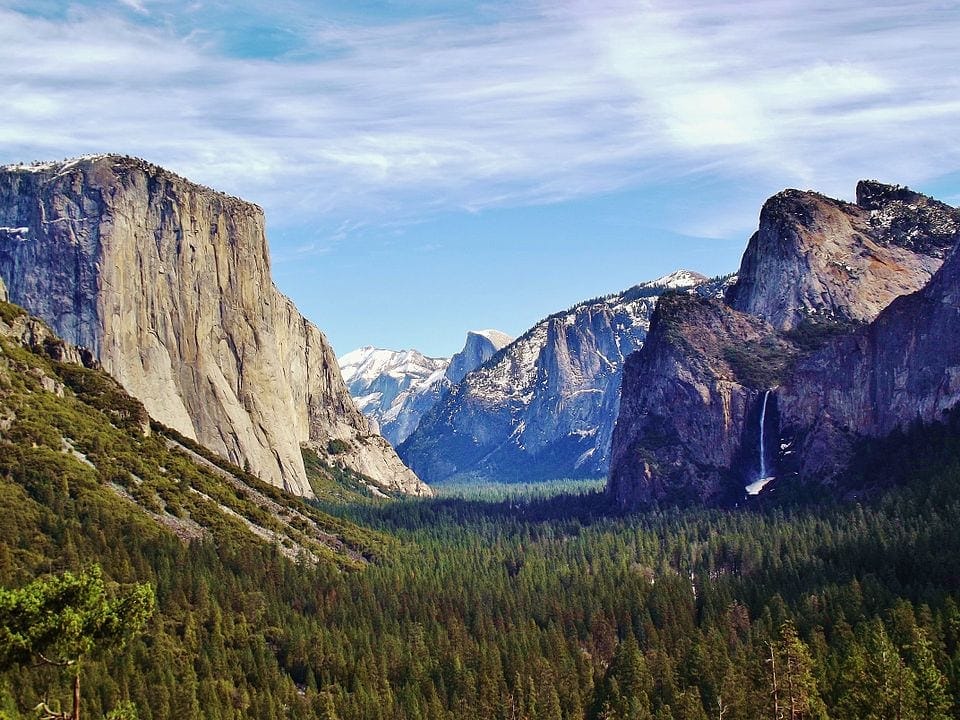
yosemite valley
A valley is a low expanse that dips below mountains or hills. They often take streams flowing through them. All the h2o from the college elevations will flow down into the valley to its lowest betoken.
Valleys are formed equally mountains are formed since not every slice of land tin get pushed up to the heights. To create remainder, some of it sinks lower while other parts go upward. Many times, valleys quietly stand up by while you look at the beauty of the mountains ahead.
There are some valleys that are breathtakingly beautiful and deserve a second await. Some of these include the Not bad Appalachian Valley, Expiry Valley, Yosemite Valley and Imperial Valley.
7.1.7 Other Types of Mountain and Glacial Landforms
- Badlands
- Butte
- Cavern
- Cliff
- Col
- Crevasse
- Cuesta
- Dirt cone
- Esker
- Flyggberg
- Gulch
- Gully
- Hanging valley
- Hill
- Hogback
- Kame
- Kettle
- Lavaka
- Moraine
- Mountain pass
- Ravine
- Ridge
- Rock shelter
- Sandur
- Scree
- Strath
viii.i Volcanic Landforms
Volcanic landforms are those formed from a volcanic eruption. These can happen underwater or above land in a vivid display of lava and ash. Typically, these devastating occurrences result in all kinds of destruction, simply they as well give rise to new landforms and sometimes entirely new islands where people alive.
Featured Volcanic Landforms
viii.one.1 Caldera
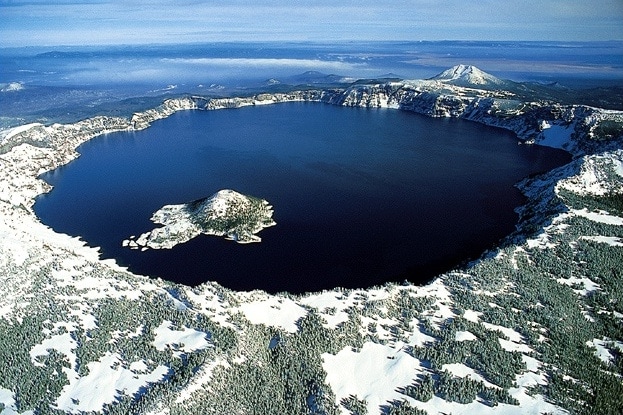
crater lake in oregon
A caldera is a crater that forms when country collapses after a volcanic eruption. Information technology might even exist the mouth of the volcano that collapses.
A great case of a caldera is Crater Lake in Oregon. When the stratovolcano, Mt. Mazama, exploded quite violently, it changed the entire landscape. The volcano's mouth complanate to form the caldera that is now a picturesque lake in the centre of a dearest National Park.
8.1.2 Geyser
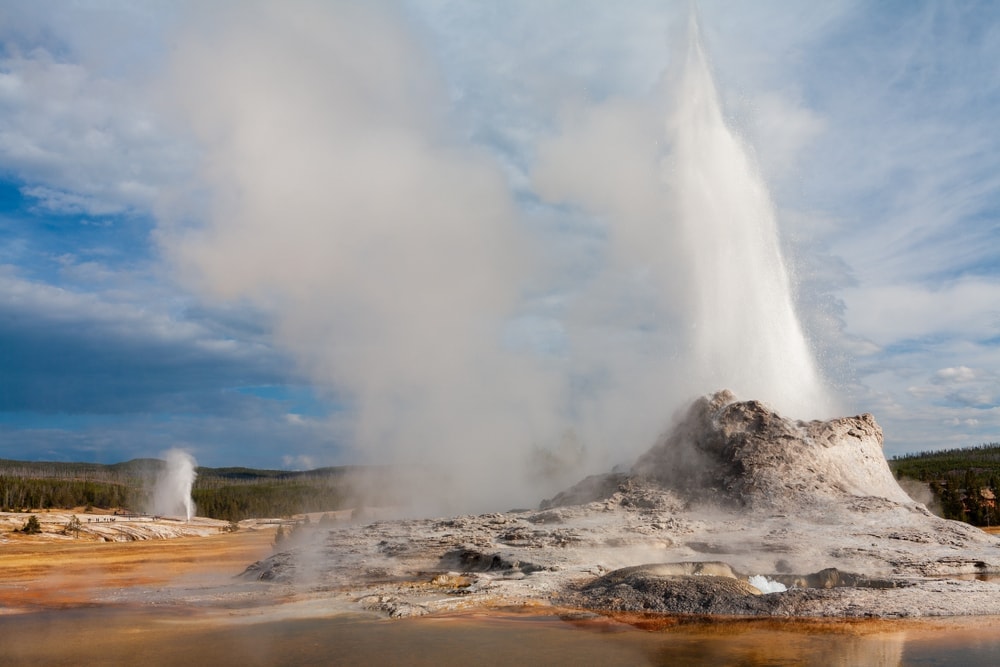
Geysers are incredible landforms that tin can be pretty active. They are eruptions of water that come out of a deep hole in the footing. At certain intervals, water and steam will shoot through the hole into the air.
Sometimes, the eruption is only a couple of inches of bubbling h2o. Other times, the geyser volition shoot the water dozens of feet up into the air to the amazement of onlookers. Most of the time, these larger and more consequent geysers are tourist attractions.
Some examples of geysers that are well worth a visit include the Beehive Geyser in Wyoming, Old Faithful in Yosemite National Park, the Bolshoi Geyser in Russia, and the Diamond Geyser in New Zealand. Wyoming is littered with geysers because of the underlying volcanic activity that even so goes on today.
viii.ane.3 Lava manifestly
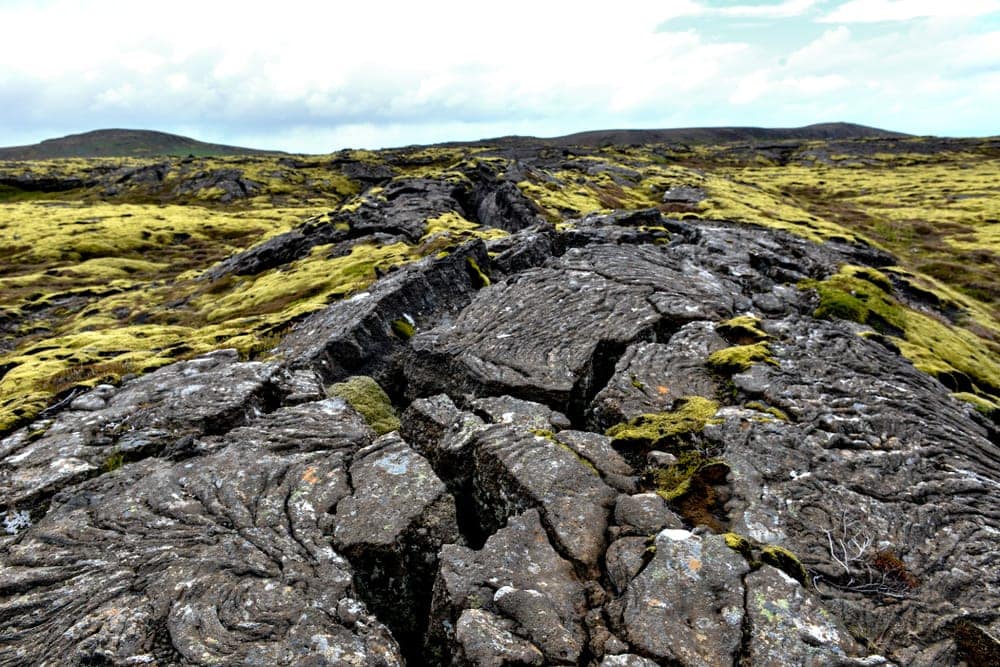
A lava plainly, or a lava field, is a big surface area well-nigh flat and filled with lava flows. It's almost entirely highly fluid basalt lava. They can go on for tens and upward to hundreds of miles.
Lava plains typically exist in an area with agile volcanic activity near the earth's crust but without as much pressure edifice upwardly to cause information technology to explode. There are a surprising number of lava plains effectually the world. For example, in that location is the Irksome Lava Field in the US and the Reykjanes Peninsula in Iceland, mostly a wasteland of lava fields.
8.1.four Volcano
Speaking of volcanic landforms wouldn't be complete without talking about the volcano itself. In that location are all kinds of volcanoes and many more that are dormant mountains instead of the belching beasts they once were.
At that place are submarine volcanoes that regularly explode without us knowing much about information technology. They might slowly build up islands as they go on to miscarry lava. Some supervolcanoes can wreak havoc over a massive swath of the world.
These supervolcanoes could cover half the earth in ash and a wide swath of state effectually them in molten lava. Yellowstone is a supervolcano that has been getting gradually closer to explosion for years.
At that place are currently six known active supervolcanoes in the world. Some explosions in the by from supervolcanoes have devastated entire populations of people. An example of this is Mount Vesuvius's explosion in Advertizing 79.
8.1.v Other Types of Volcanic Landforms
- Complex volcano
- Crater lake
- Cryovolcano
- Guyot
- Lava
- Lava dome
- Lava spine
- Maar
- Malpais
- Mud volcano
- Pit crater
- Rootless cone
- Sand volcano
- Seamount
- Shield volcano
- Stratovolcano
- Subglacial mound
- Submarine volcano
- Tuya
- Vent
- Volcanic arc
- Volcanic dam
- Volcanic field
- Volcanic island
- Volcanic plateau
- Volcanic plug
Interesting Facts near Landforms
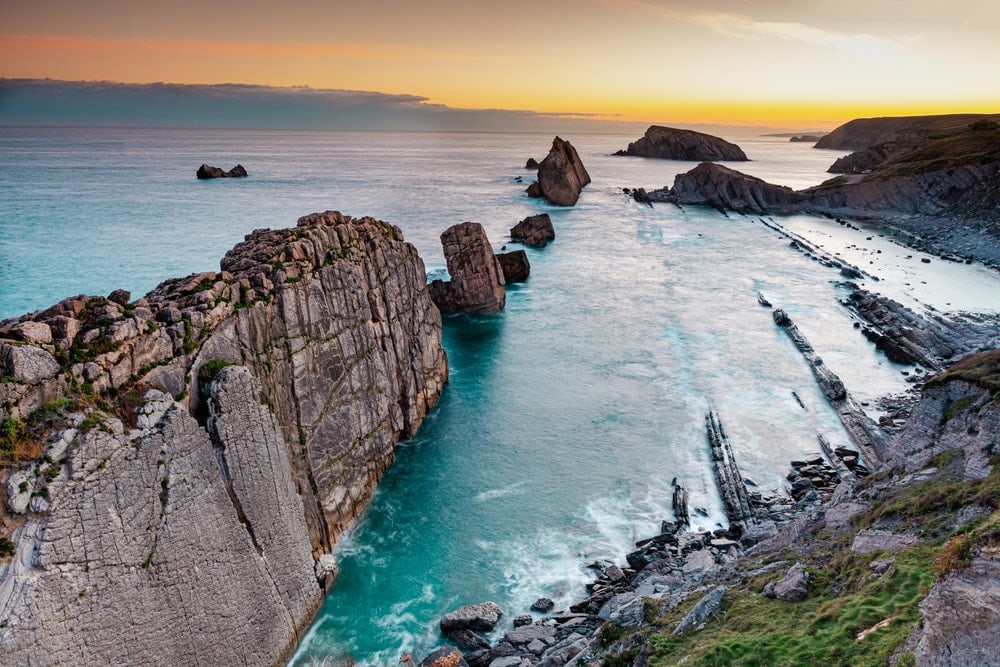
ane|Technically, water bodies are considered landforms.
The word "land" in landform would requite near people the idea that information technology has to be on land to be a landform. That isn't ever true. Technically, oceans, rivers, and lakes all qualify as landforms. They might be water bodies, but the state shapes them.
2|Landforms play an influential part in weather conditions.
A landform isn't just at that place to wait pretty or interesting. They play a prominent office in the way that our climate is in each part of the globe. Mountain ranges and h2o bodies affect the most modify. Mountain ranges act as walls against winds and storms that travel effectually the planet. That is why it's normal to see lush greenery on one side of a range and a desert on the other.
3|Landforms are but temporary.
Although a landform might accept been around and looked the same for thousands of years, they are all only temporary. Millenia ago, our world looked very different. As volcanoes explode and tectonic plates continue to shift, our world will probable continue to change. Some mean solar day, the mountains might even autumn back into the earth.
Landforms Of The Coastal Plains,
Source: https://outforia.com/types-of-landforms/
Posted by: haydenconevenibary.blogspot.com


0 Response to "Landforms Of The Coastal Plains"
Post a Comment